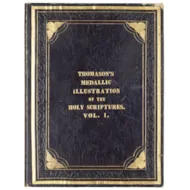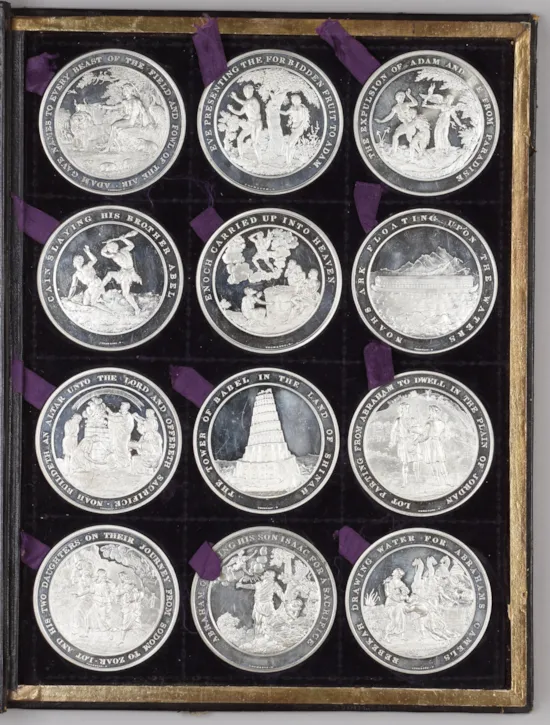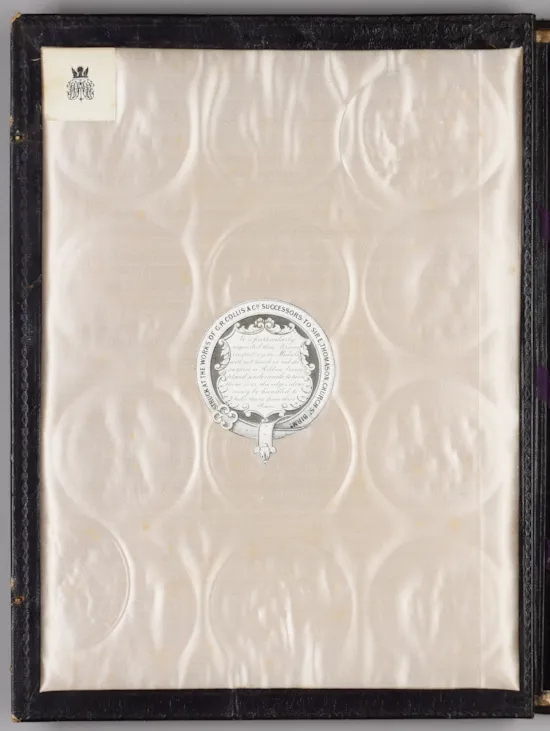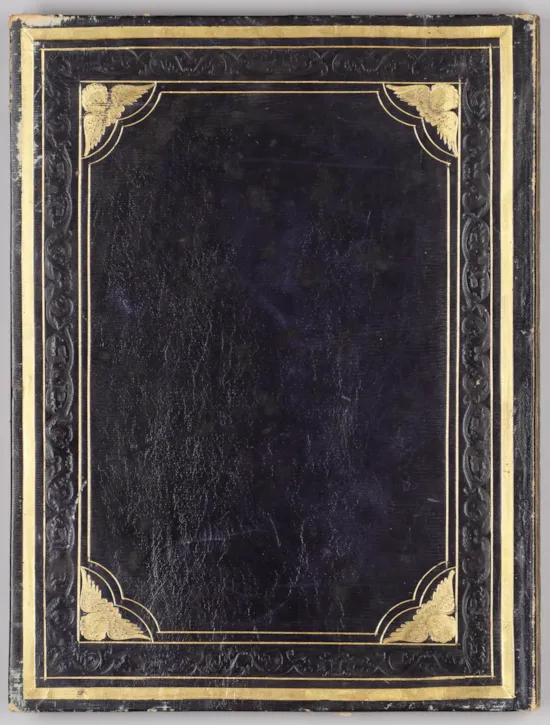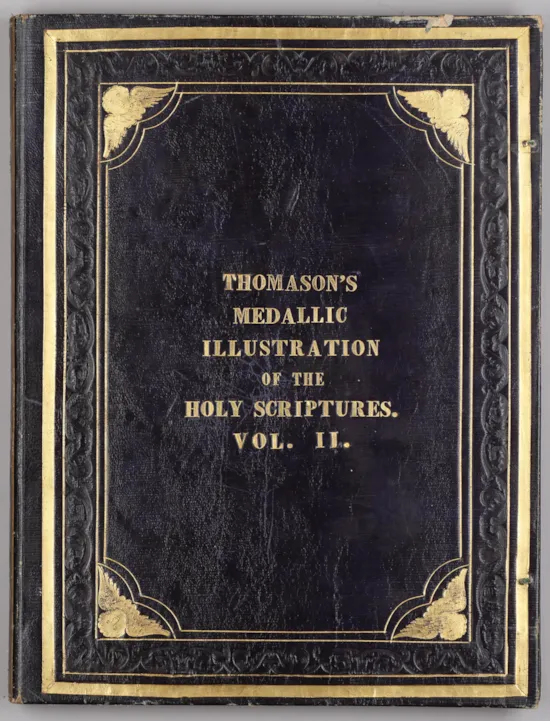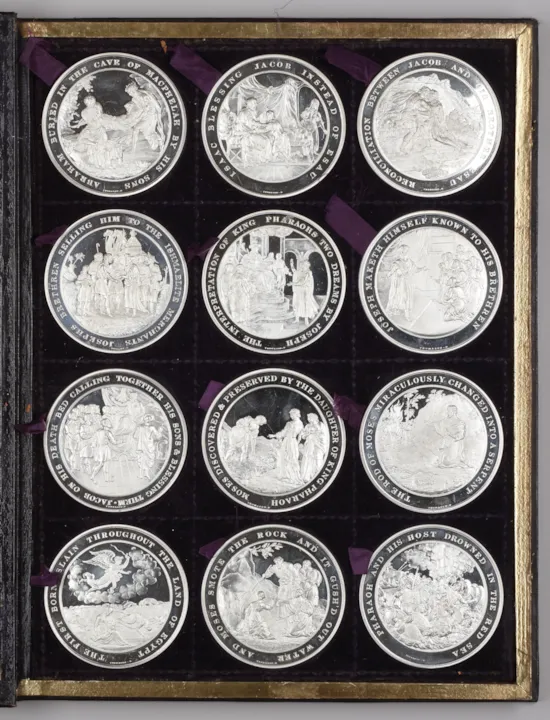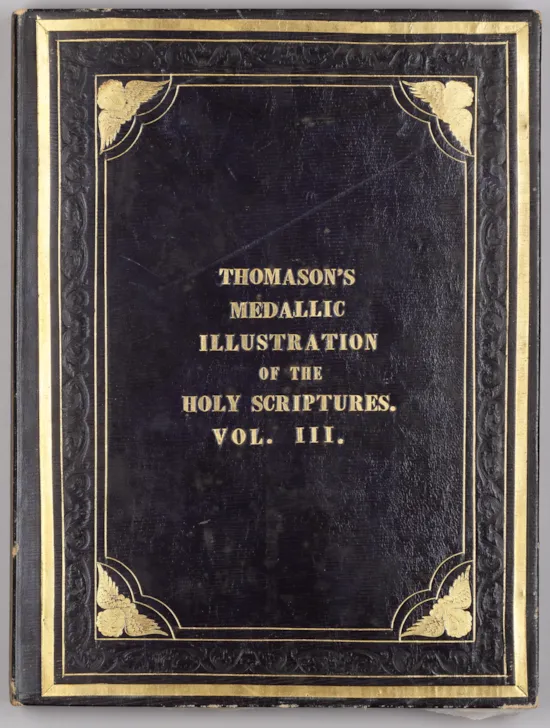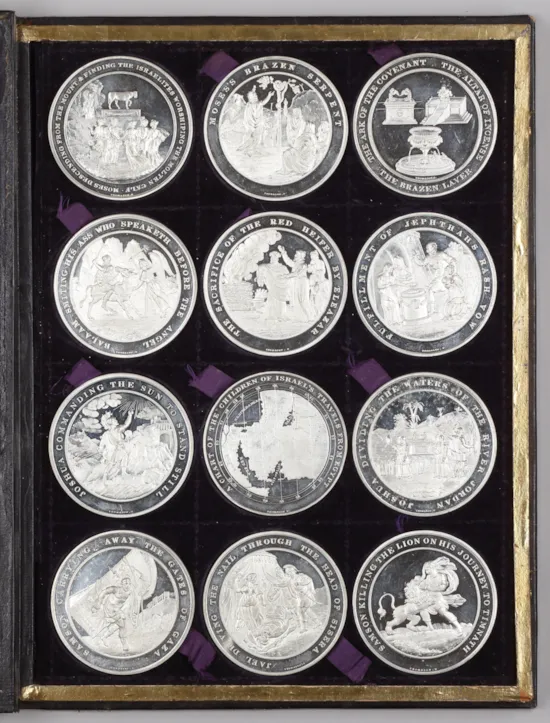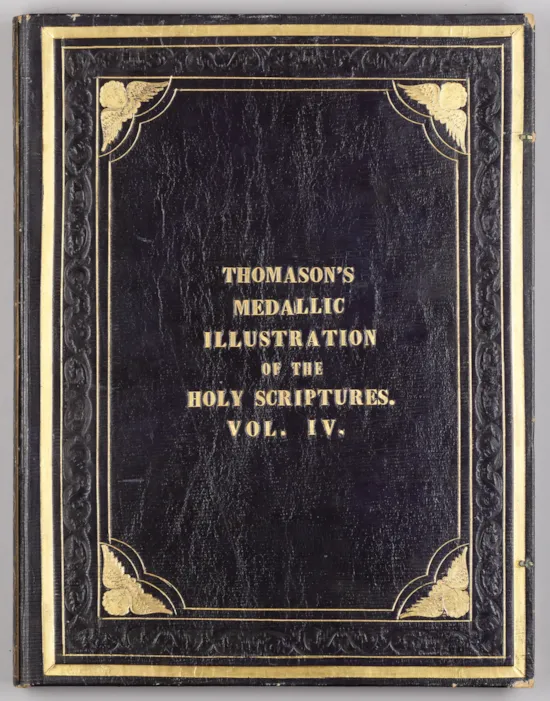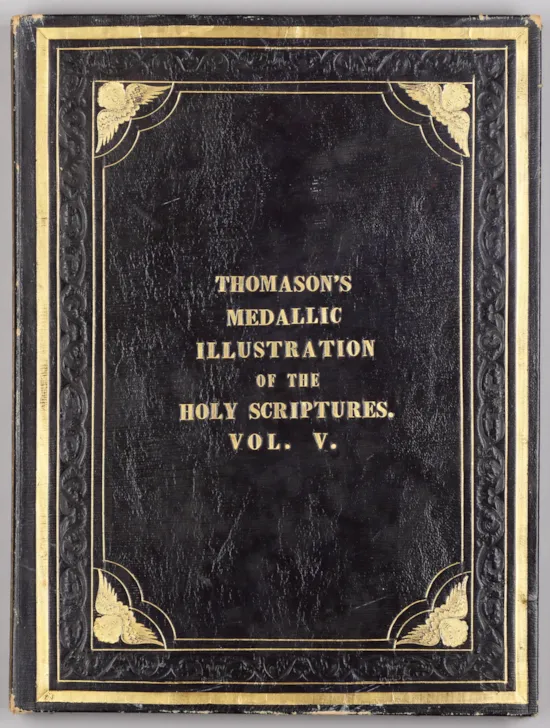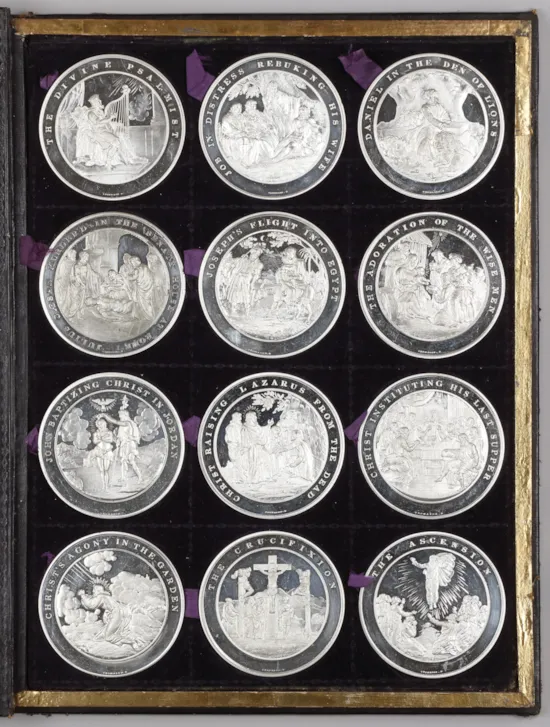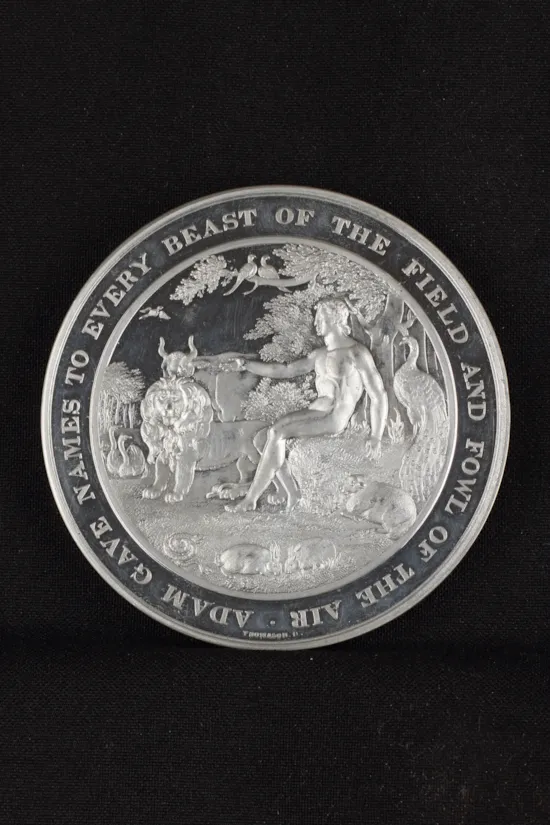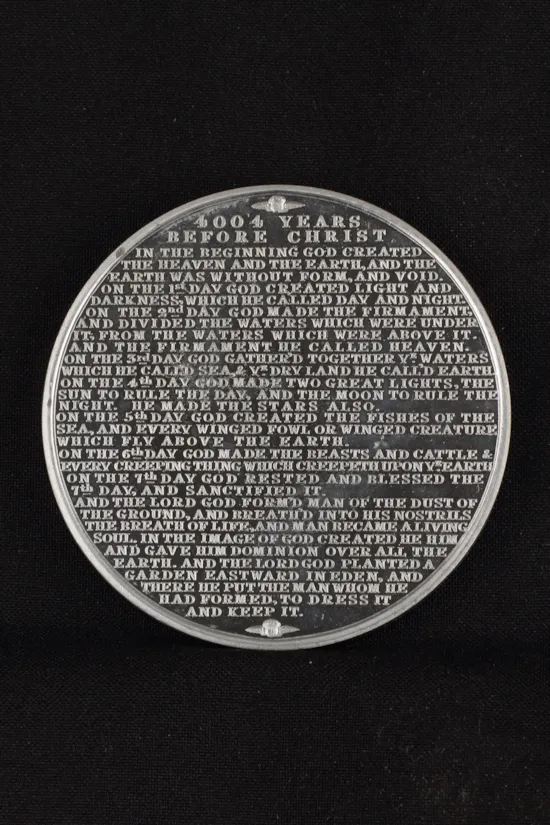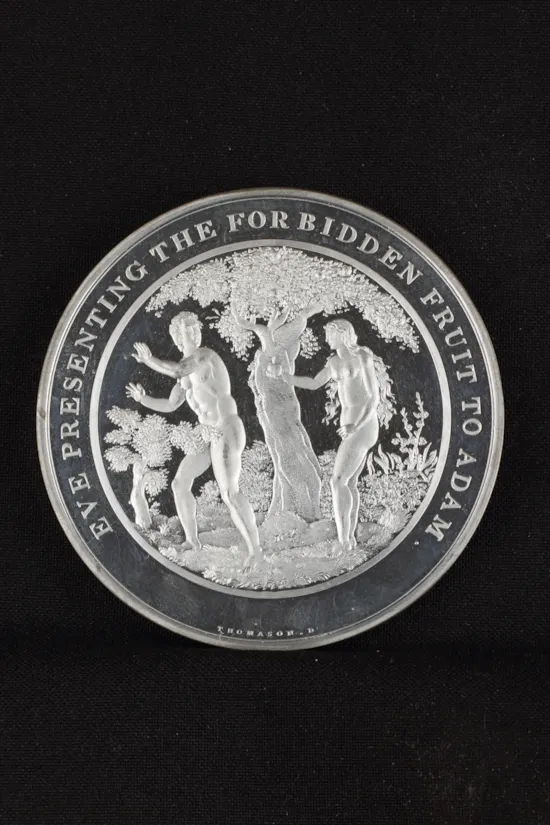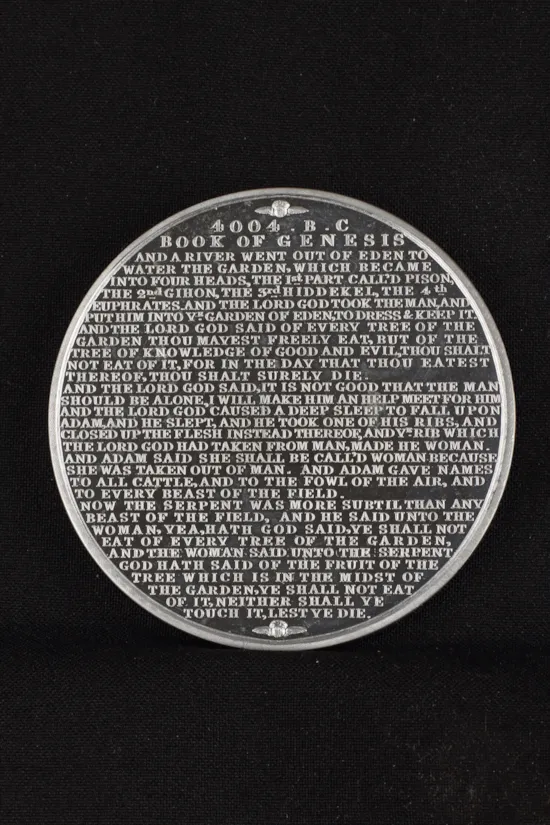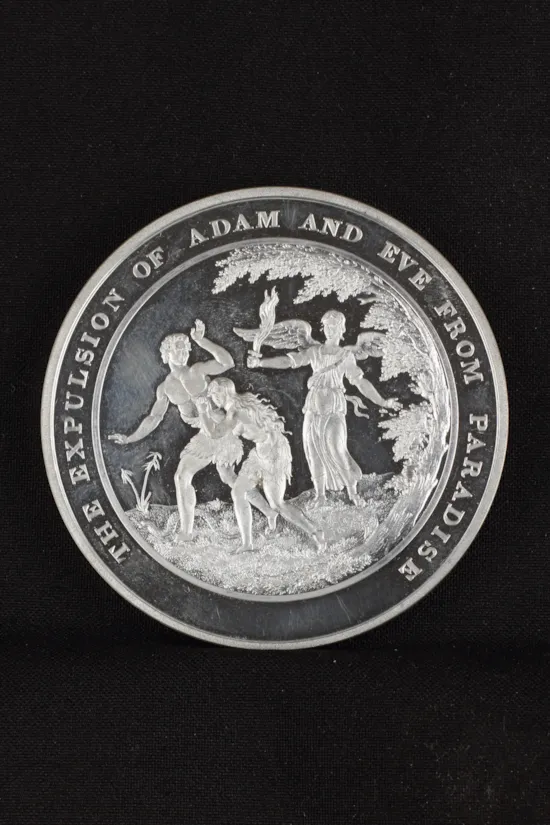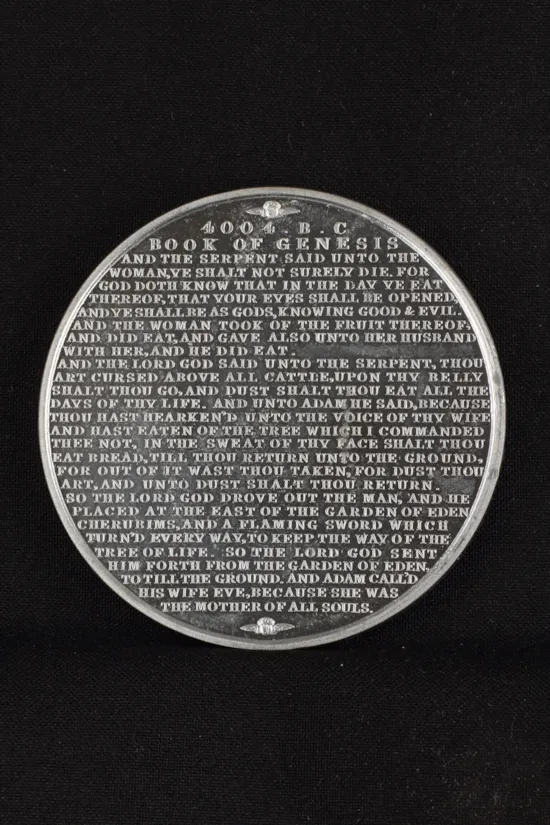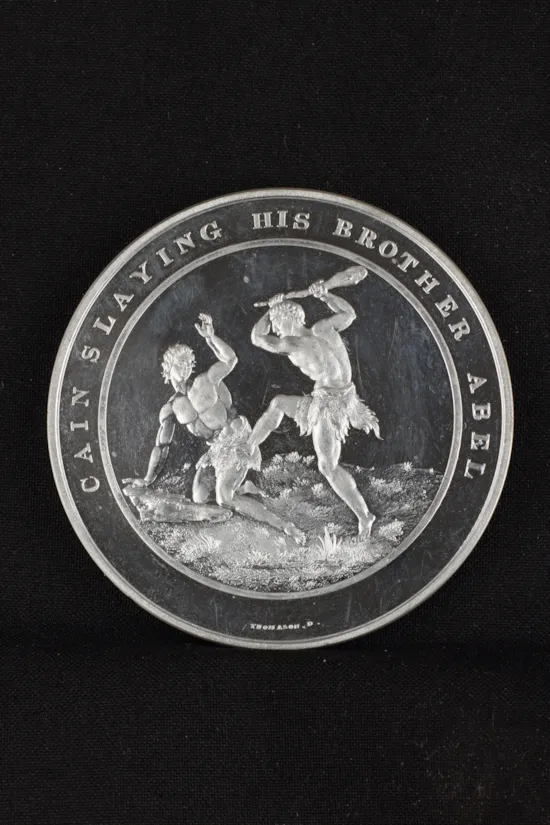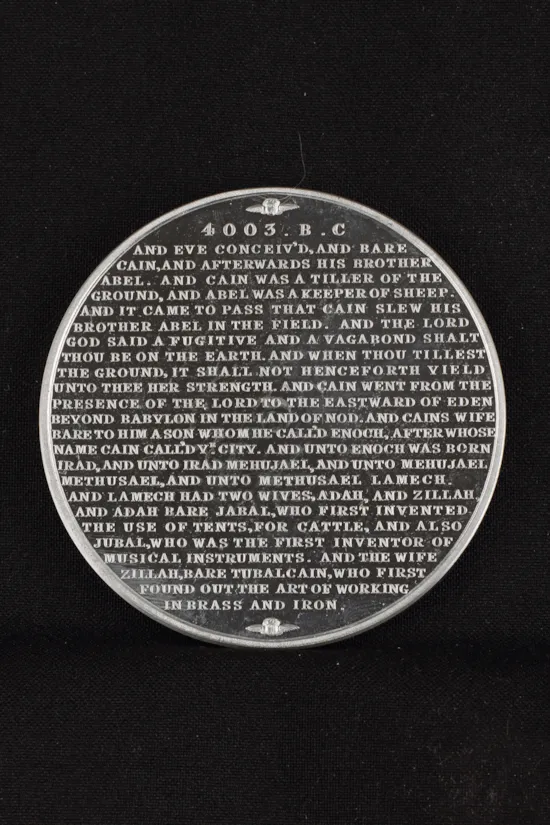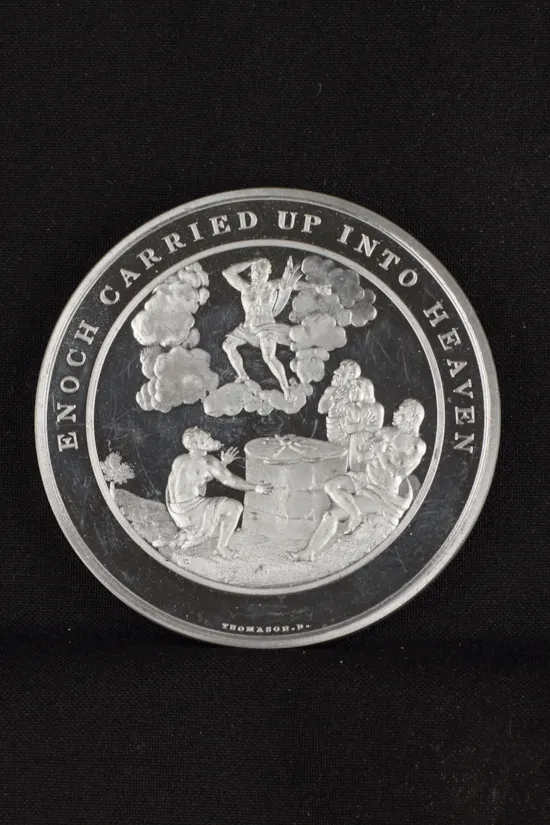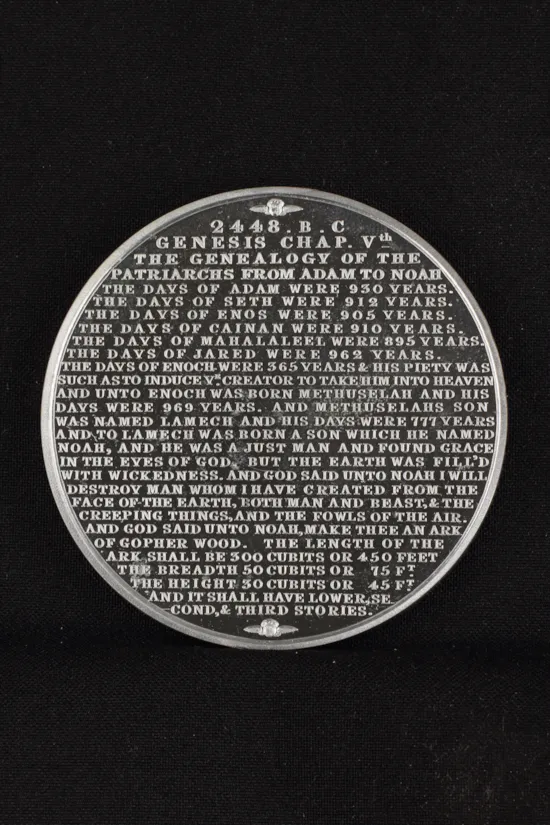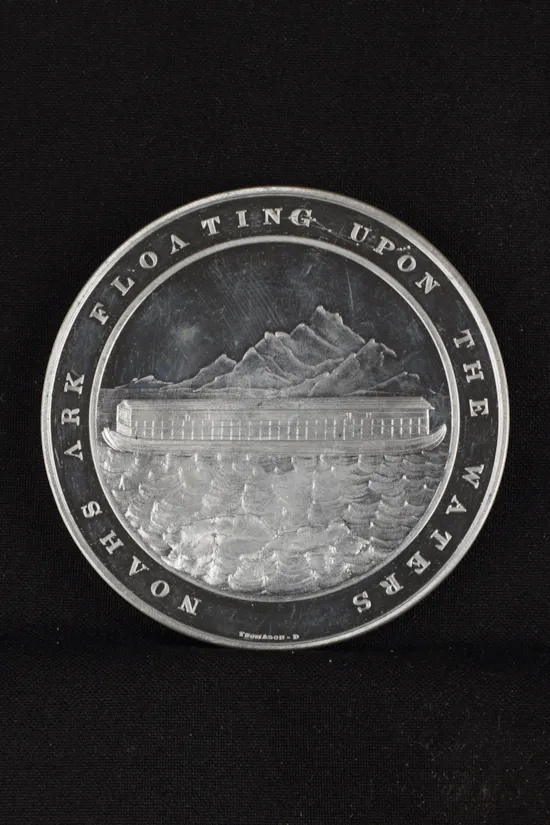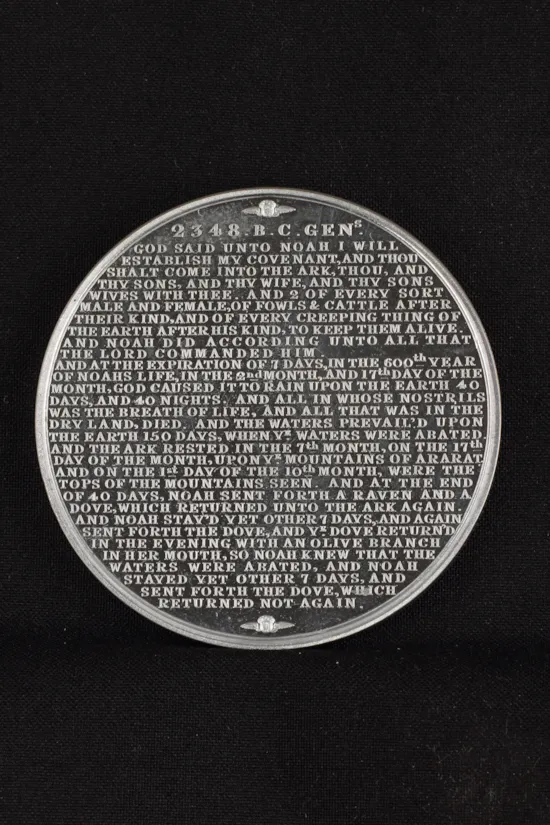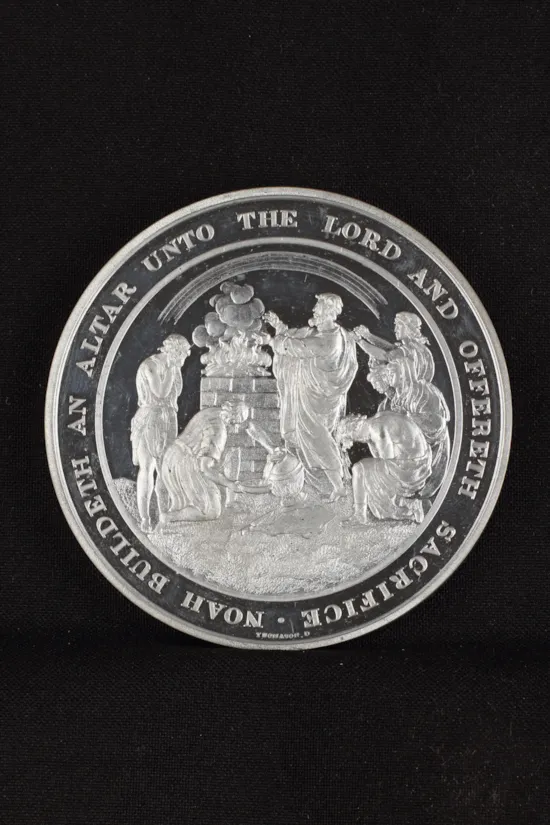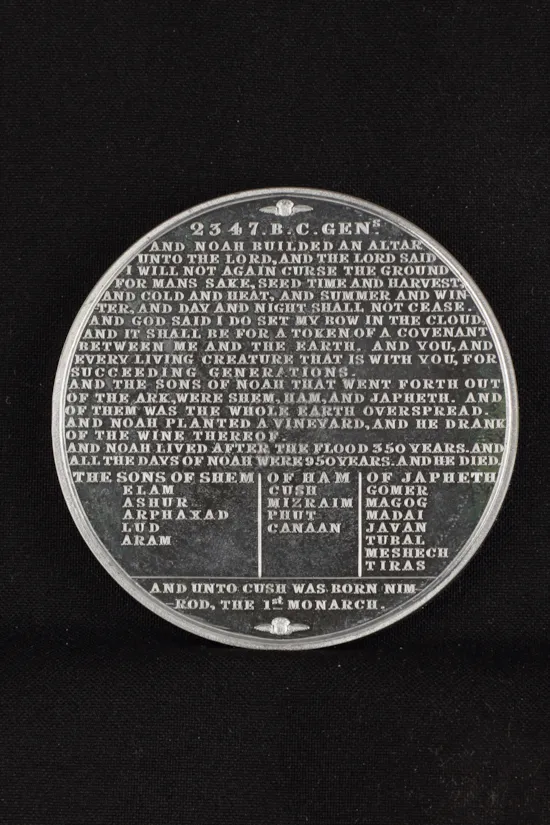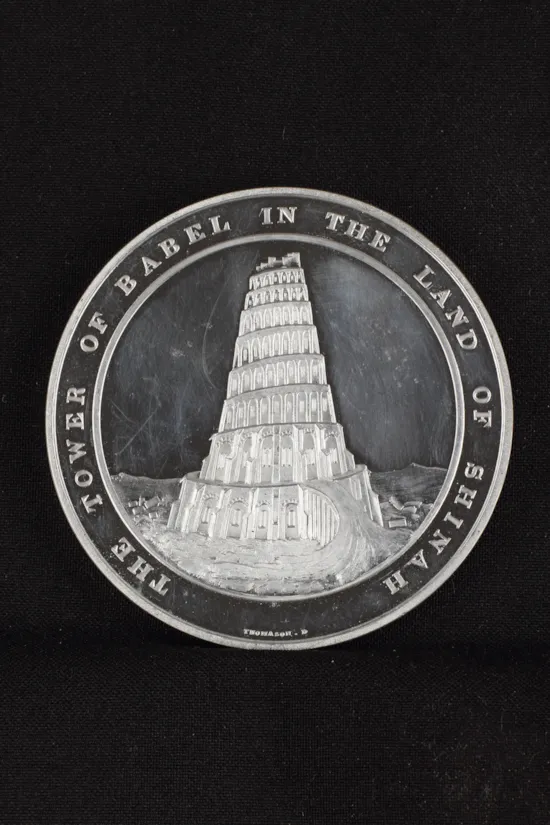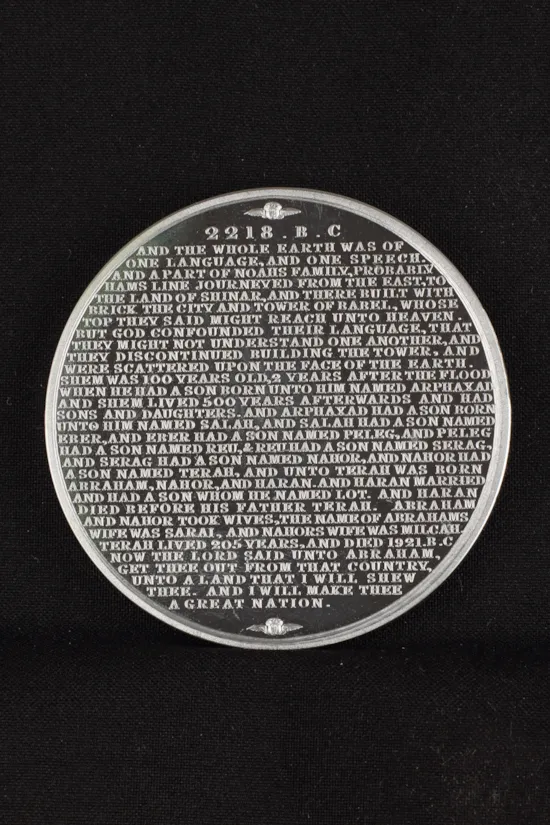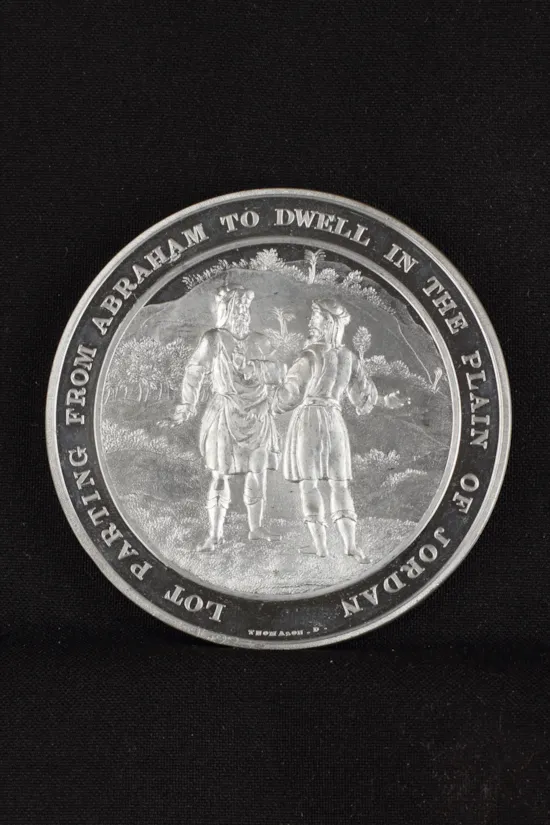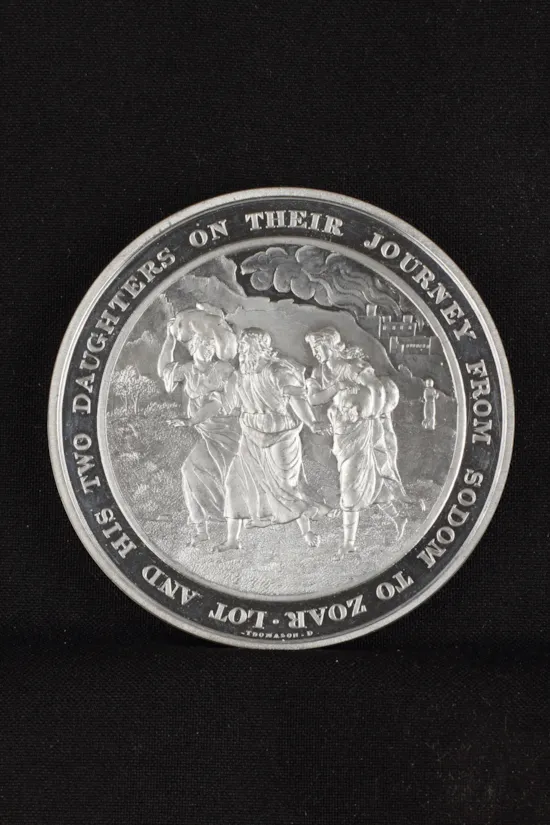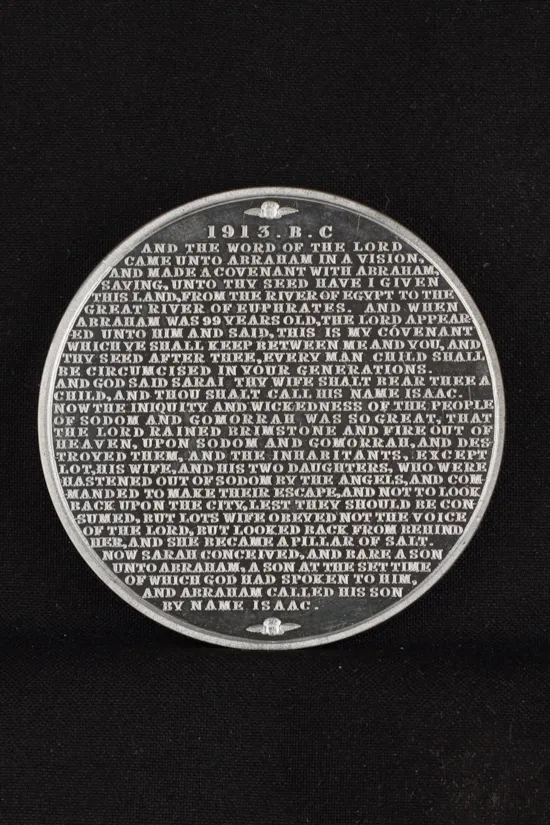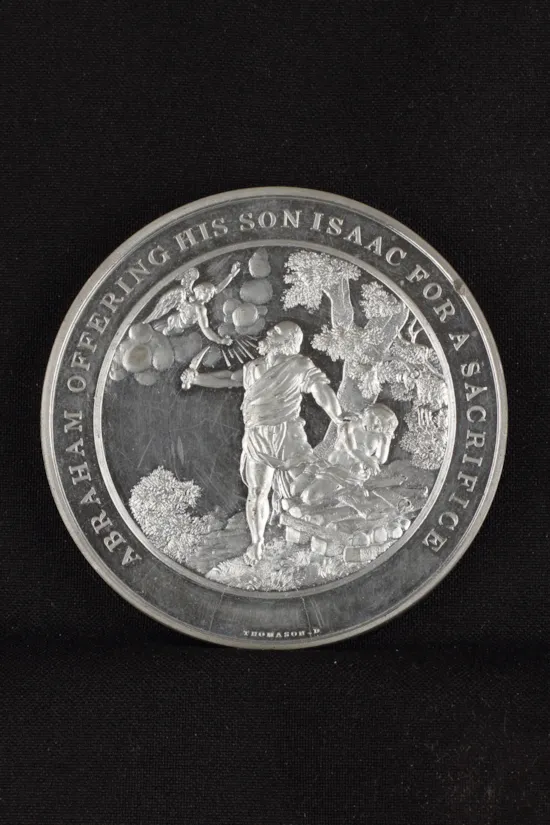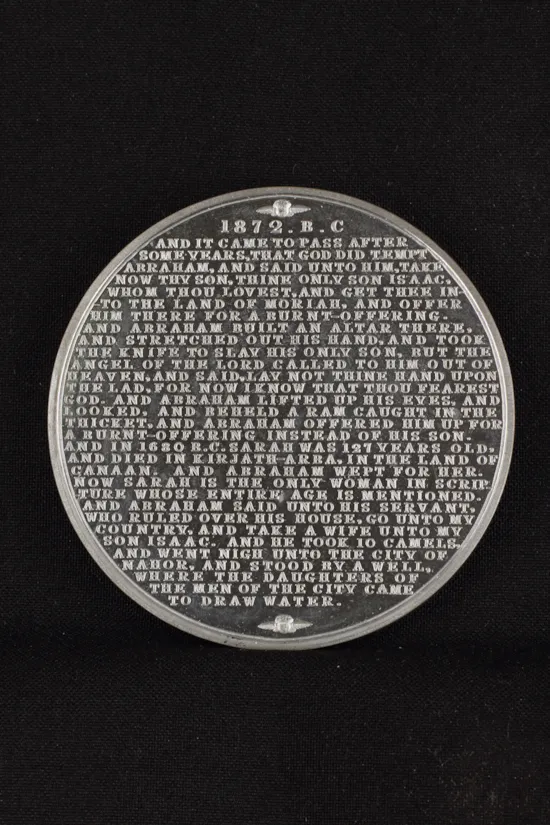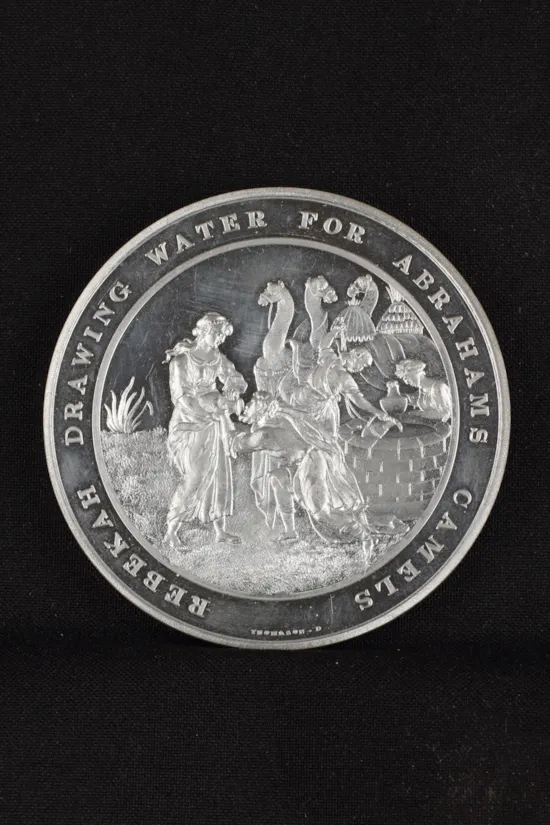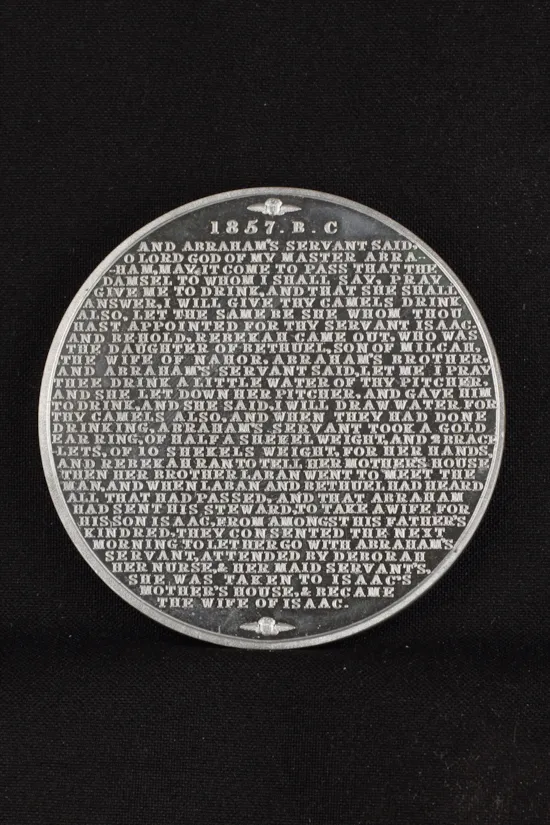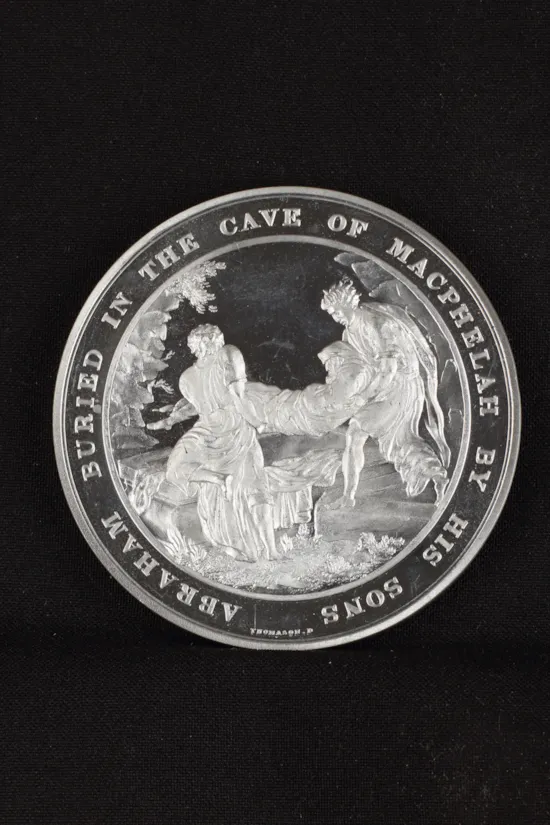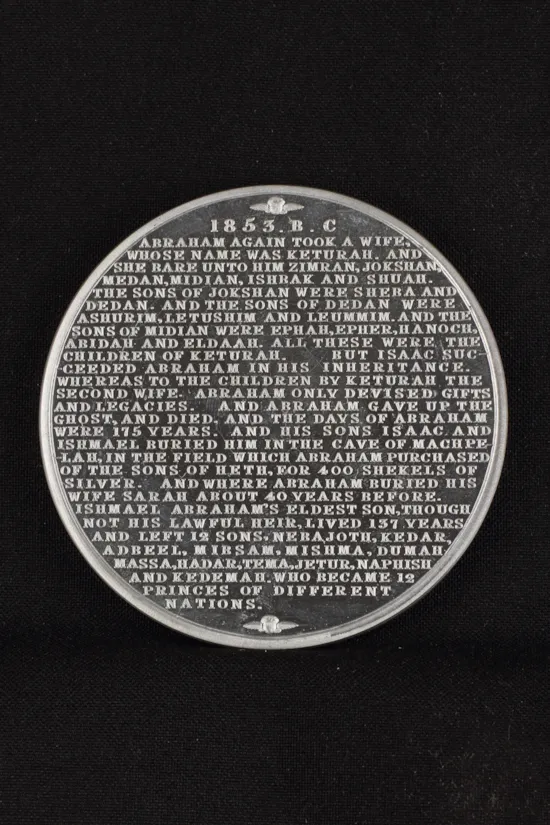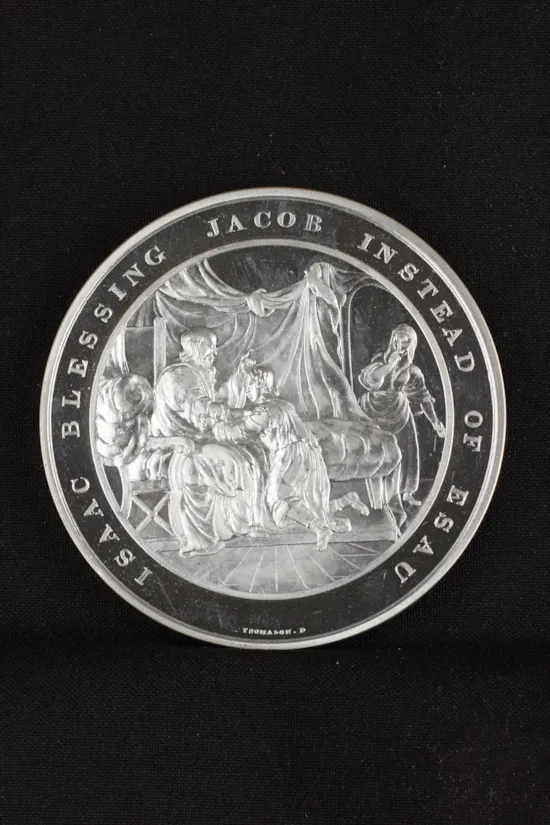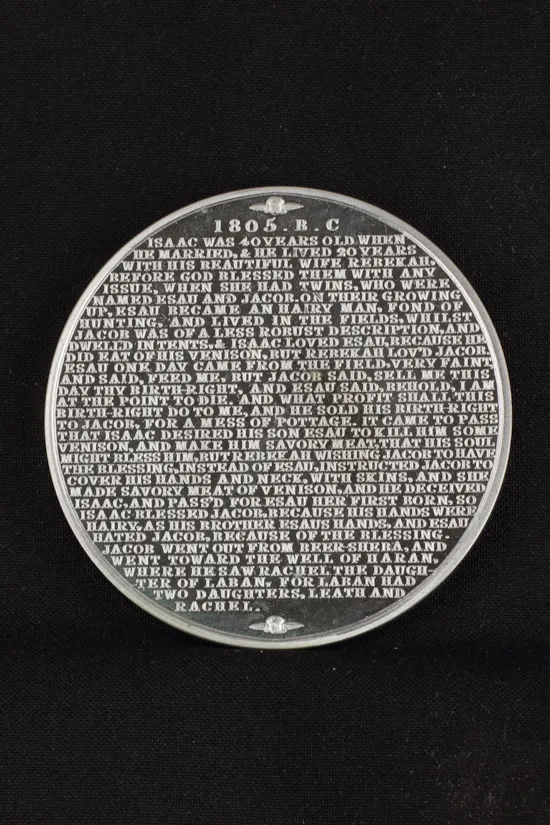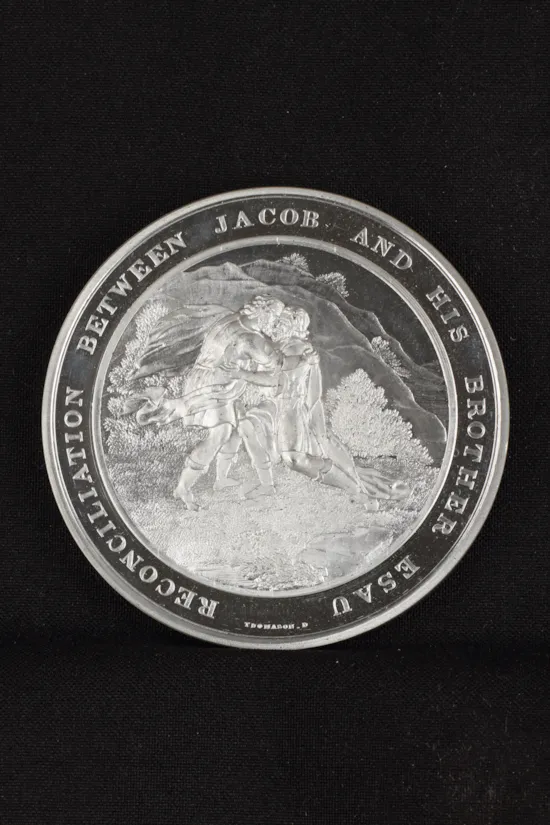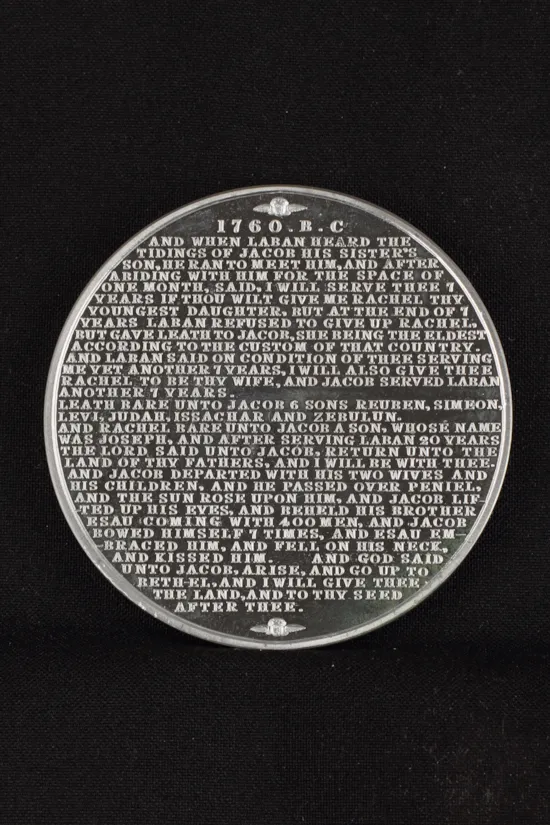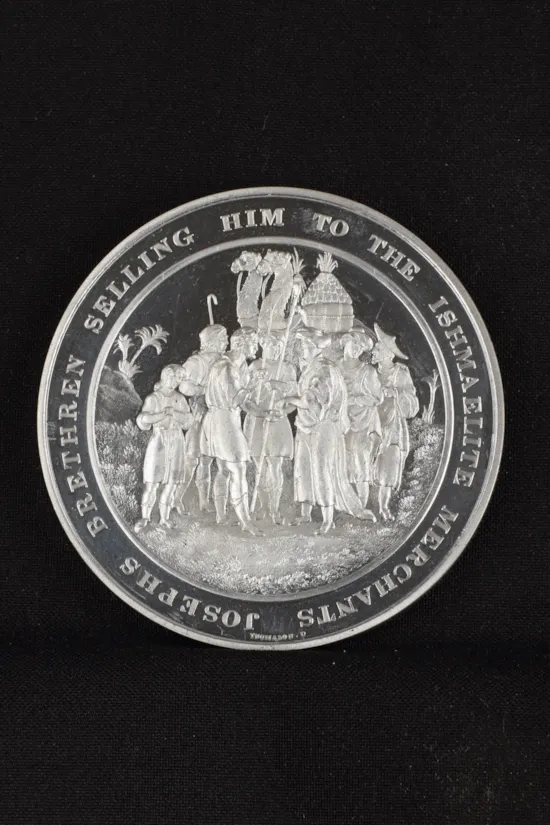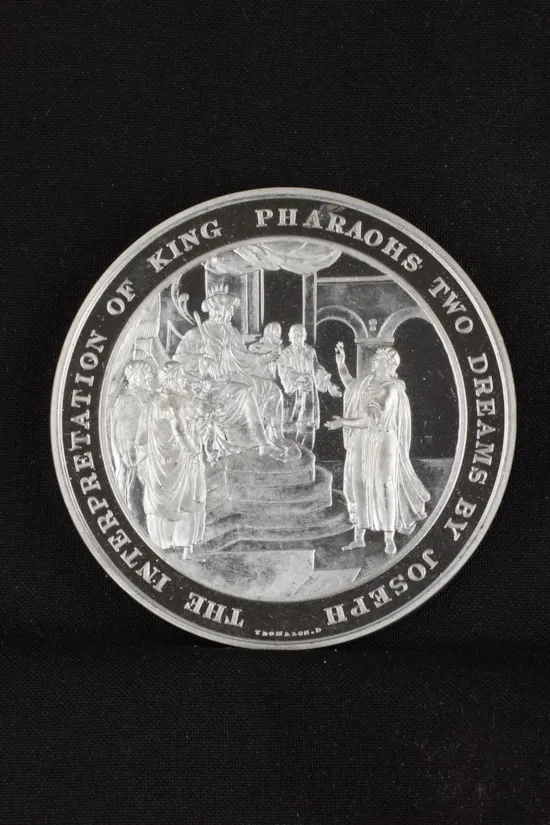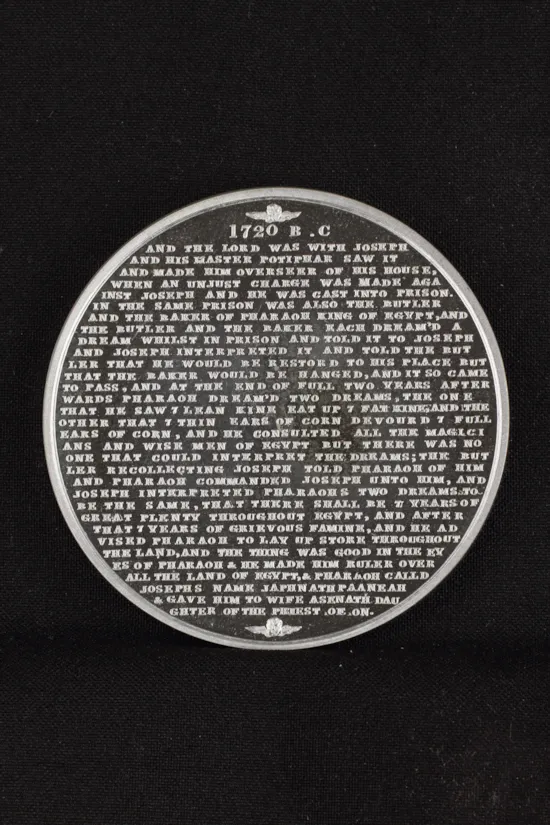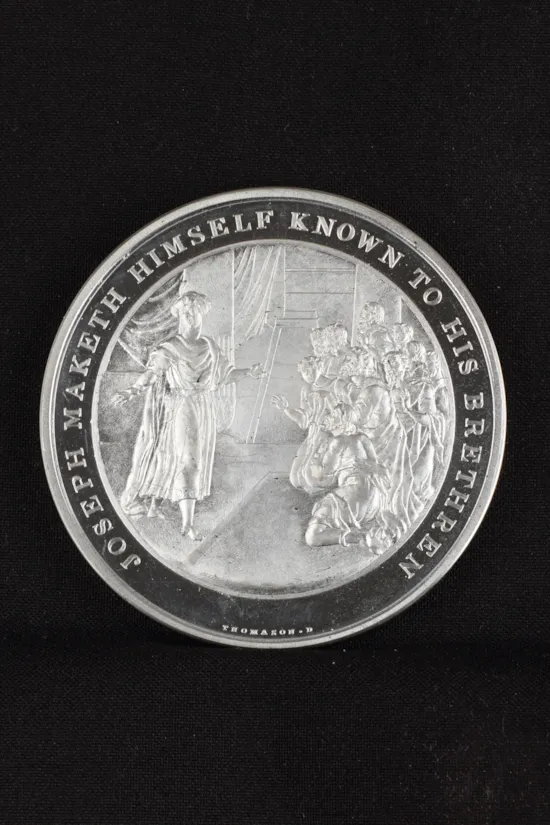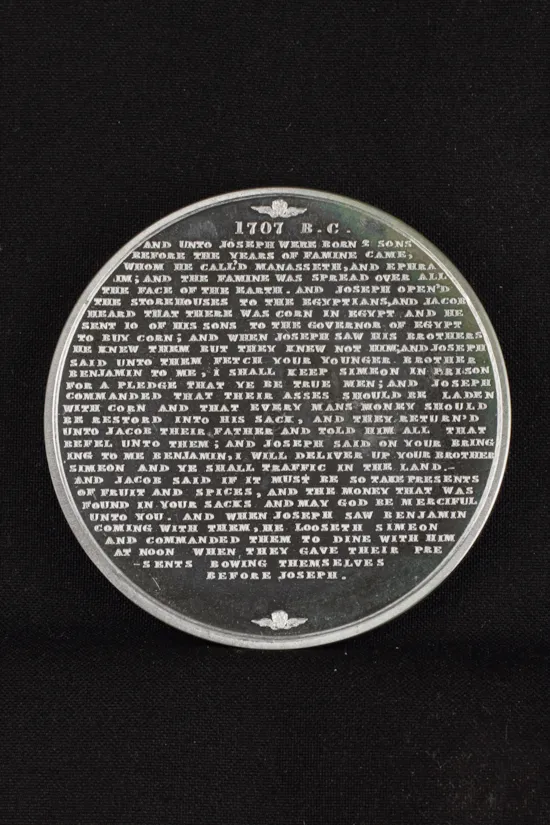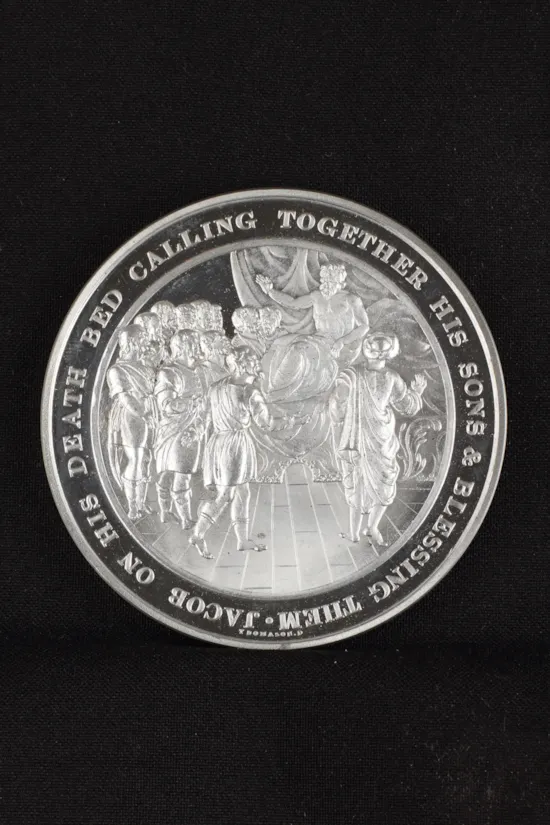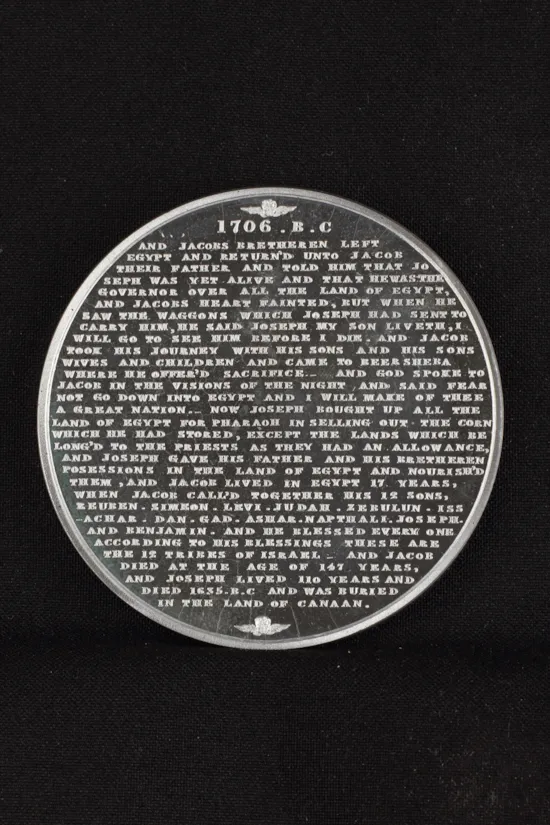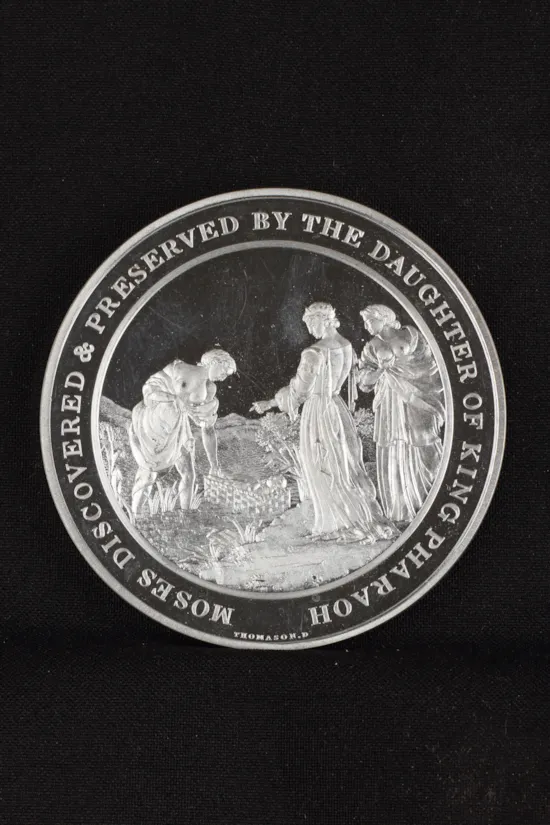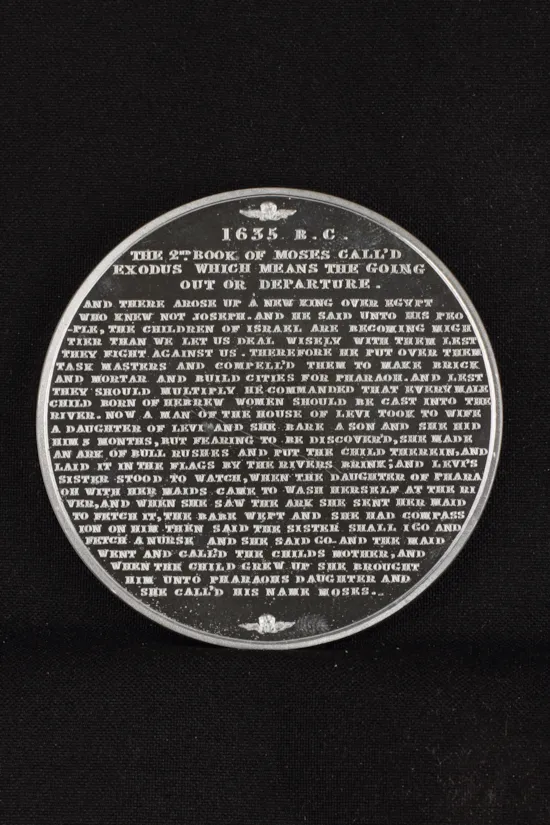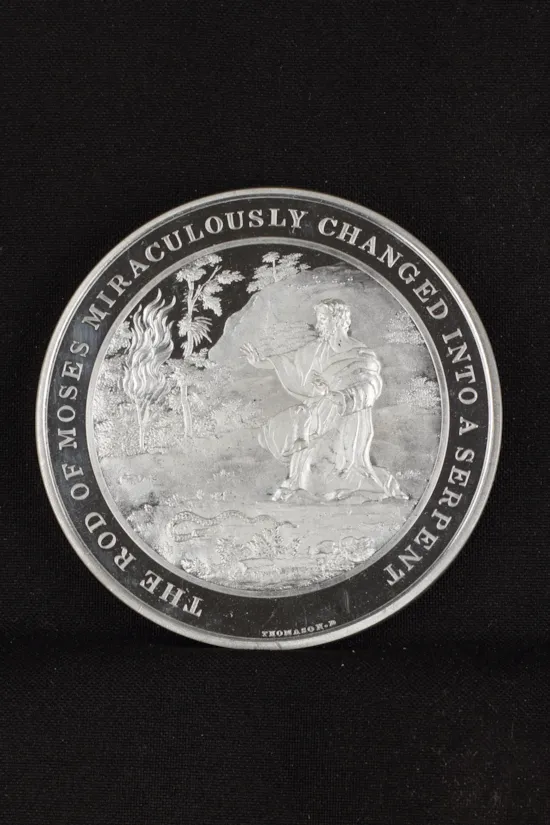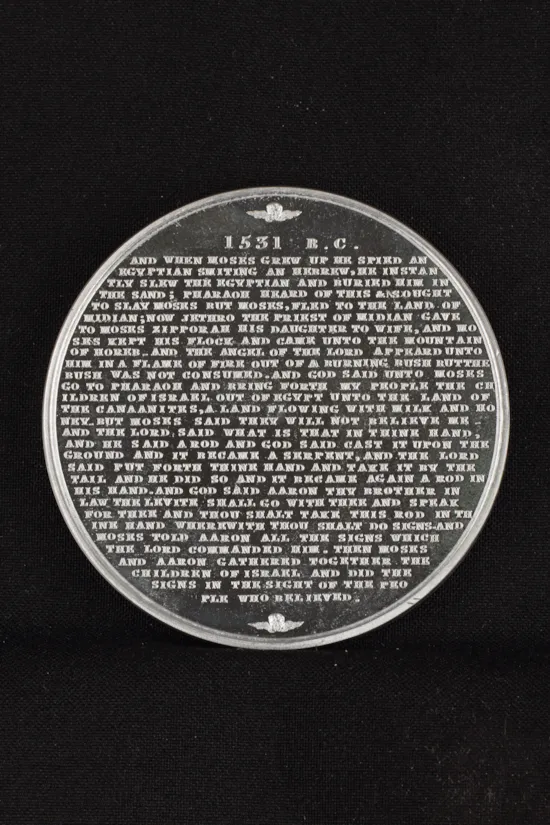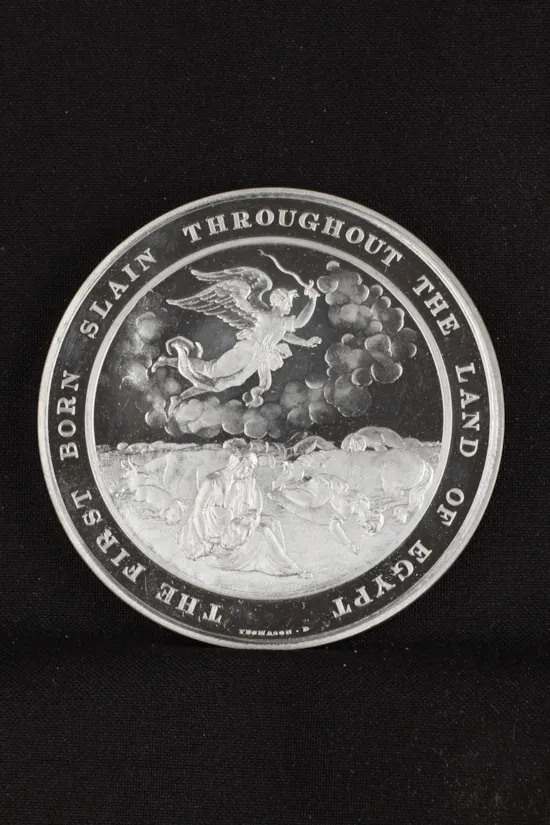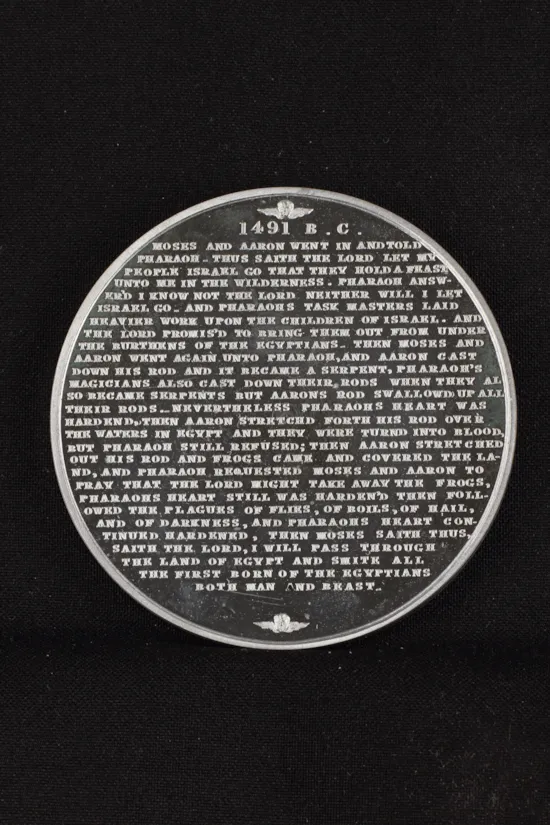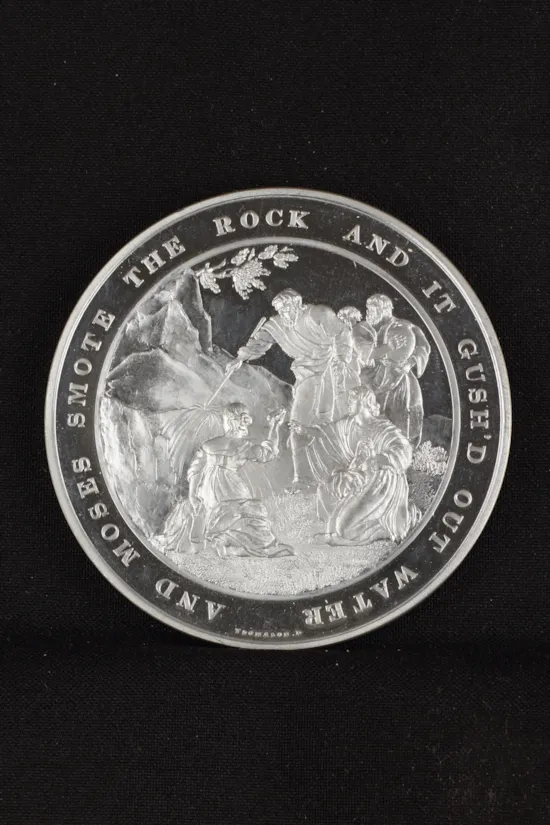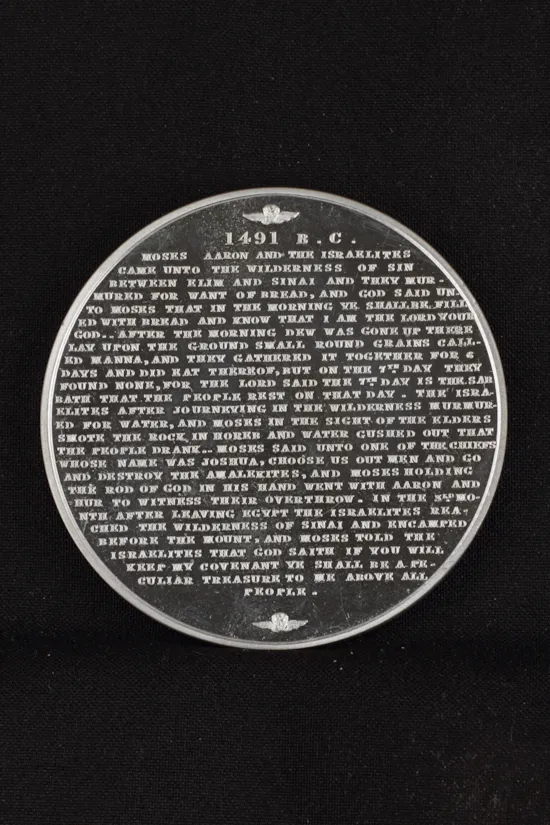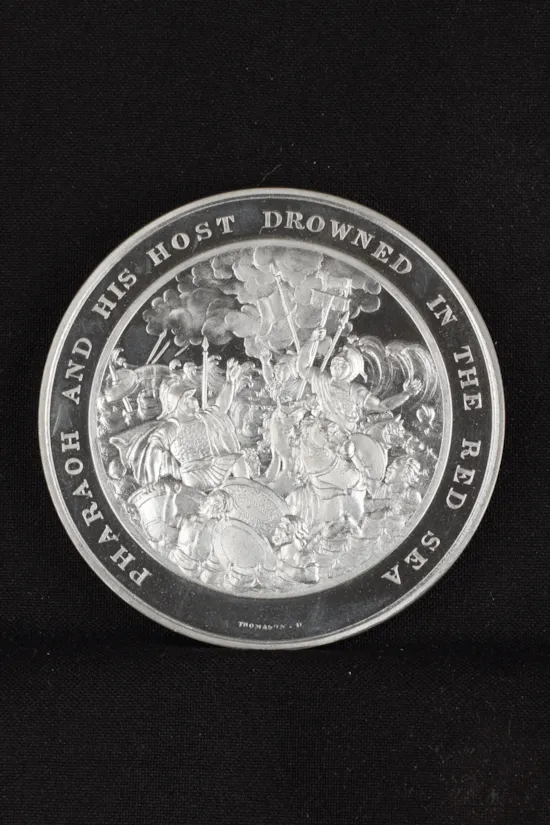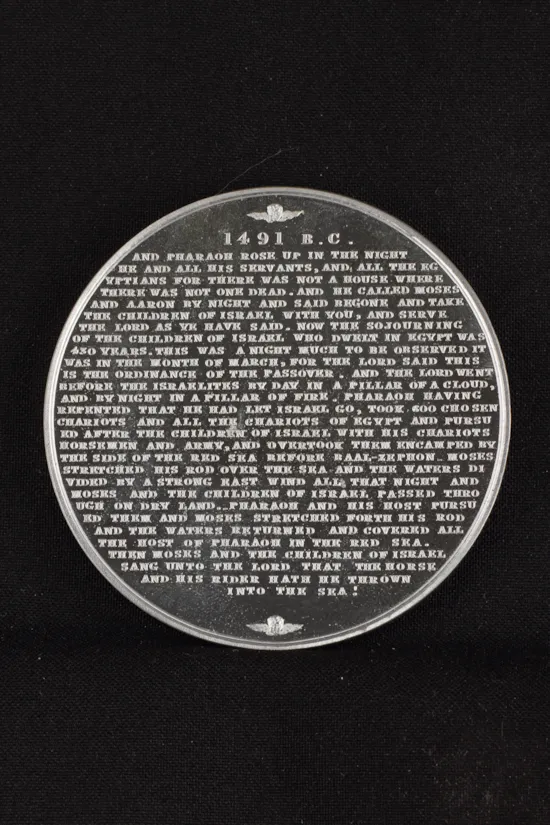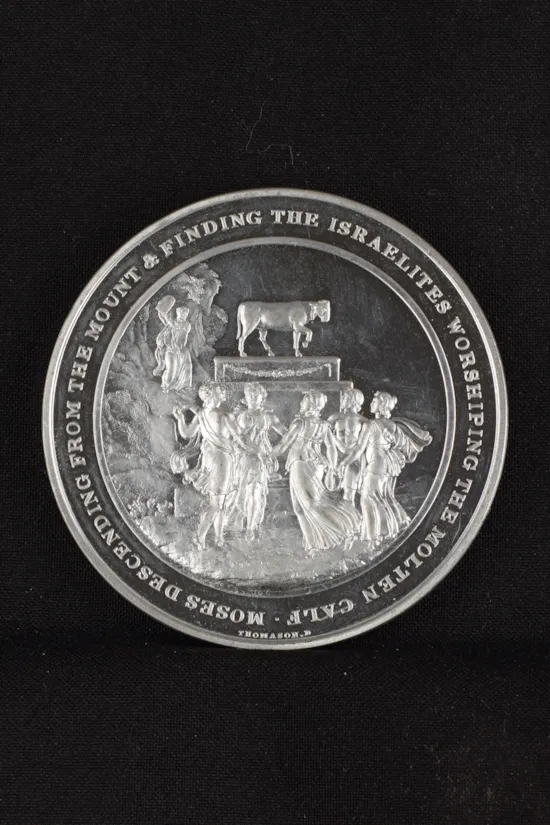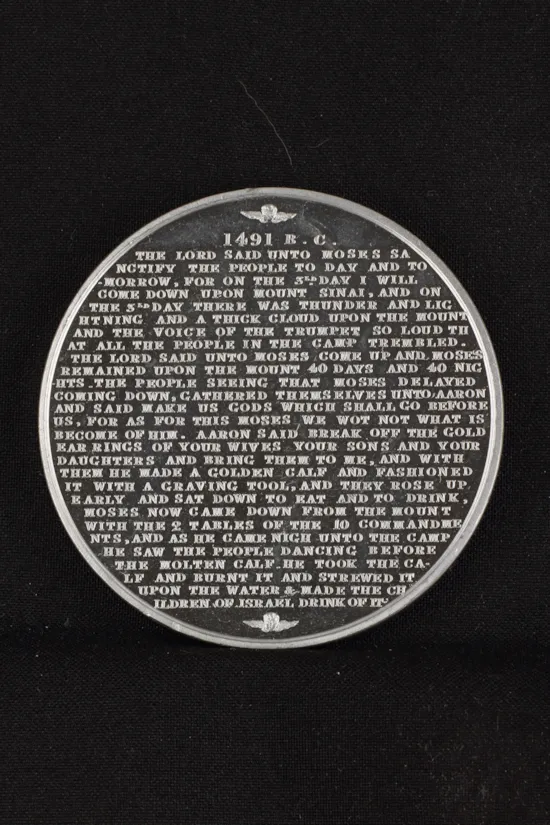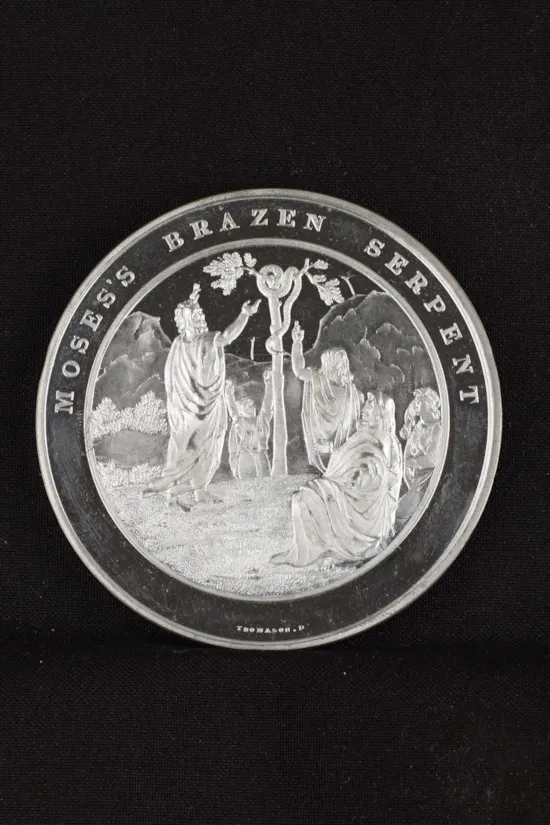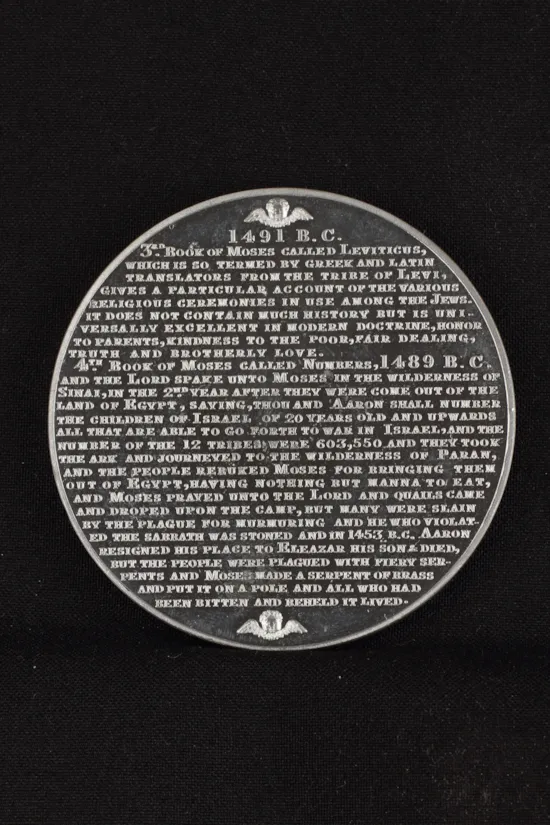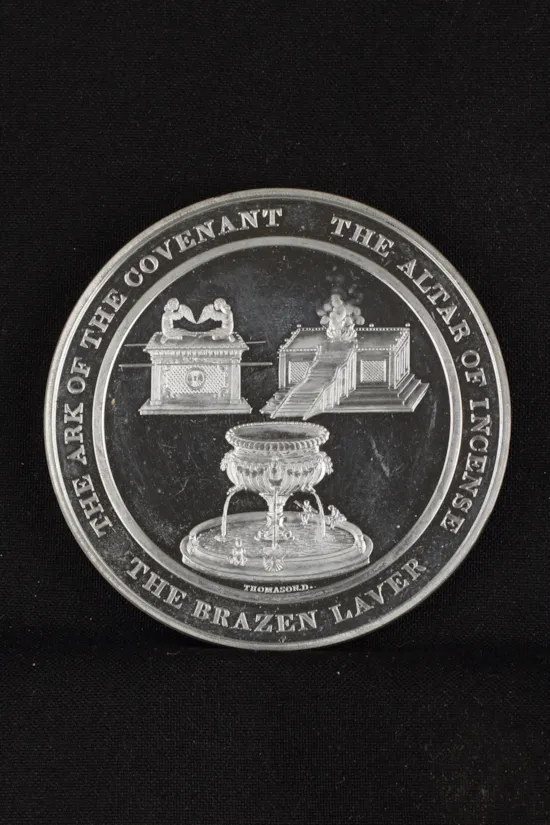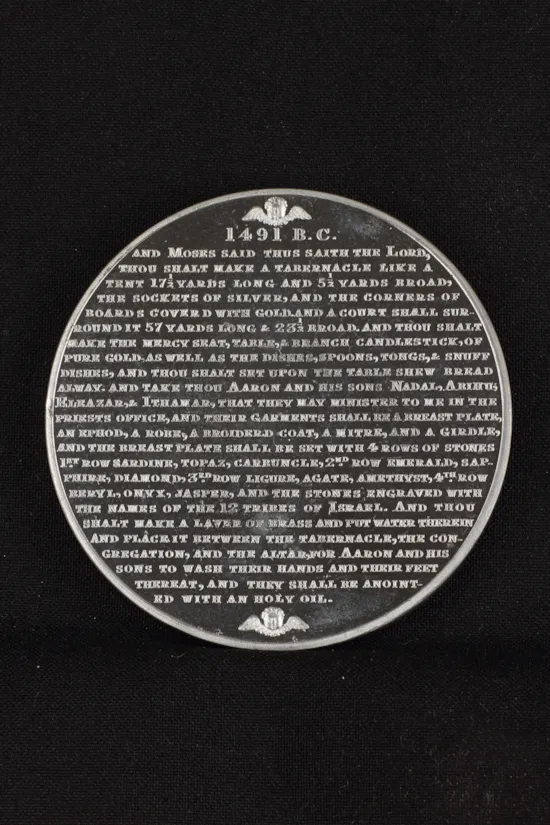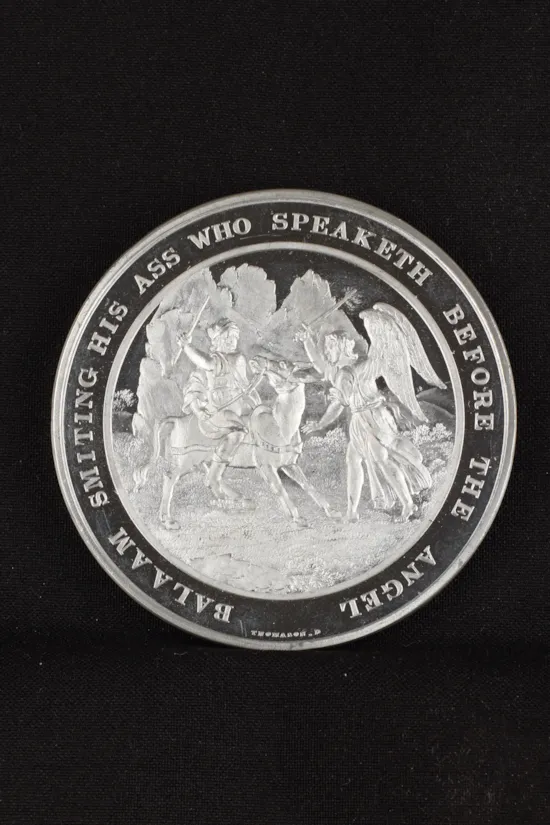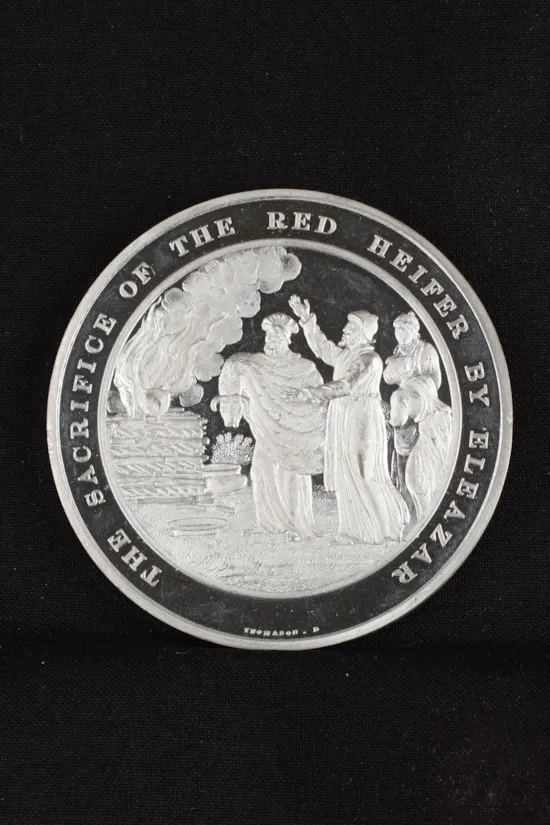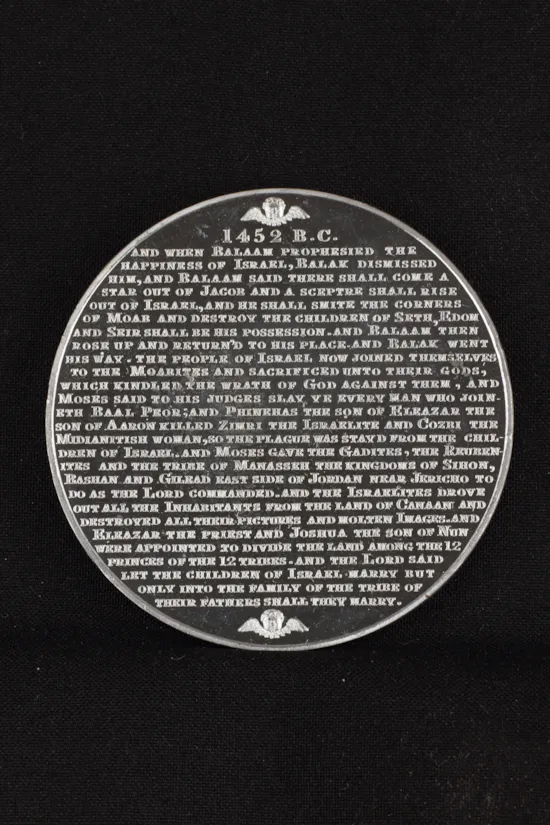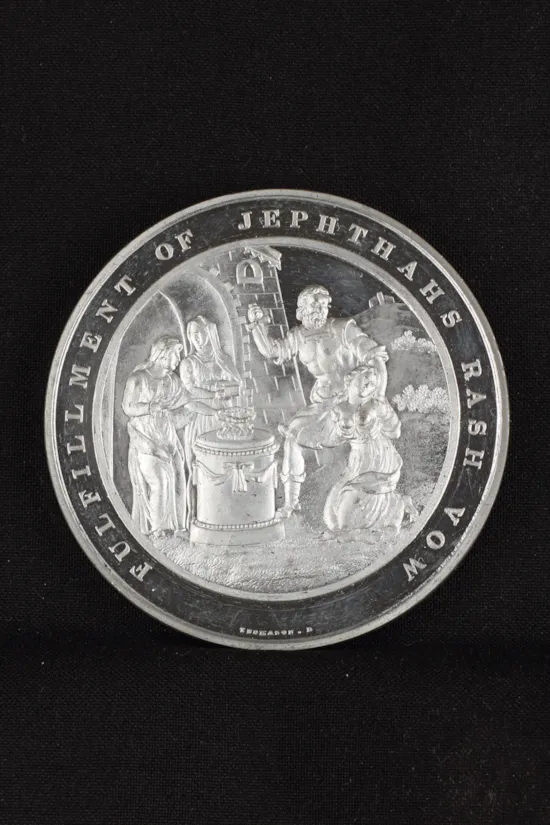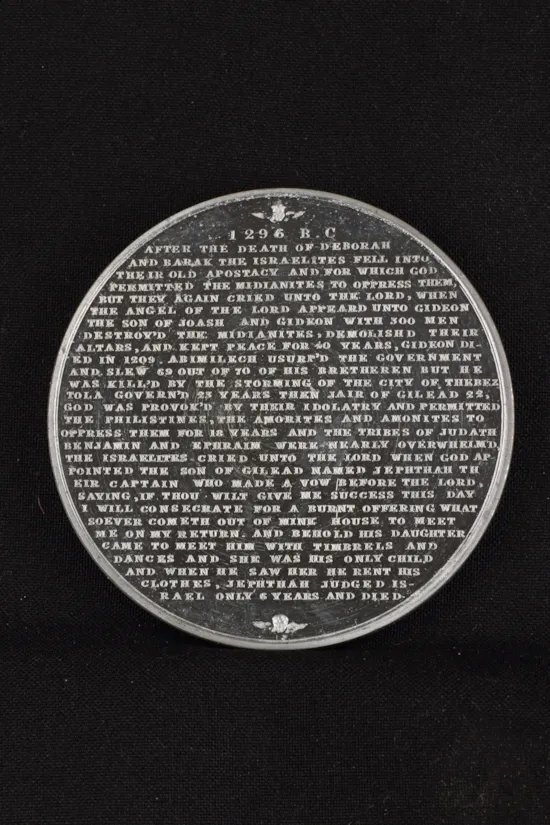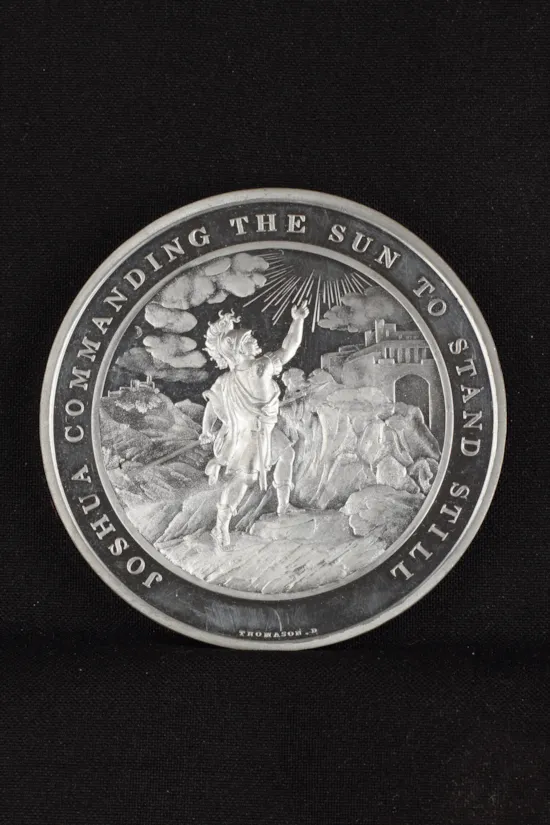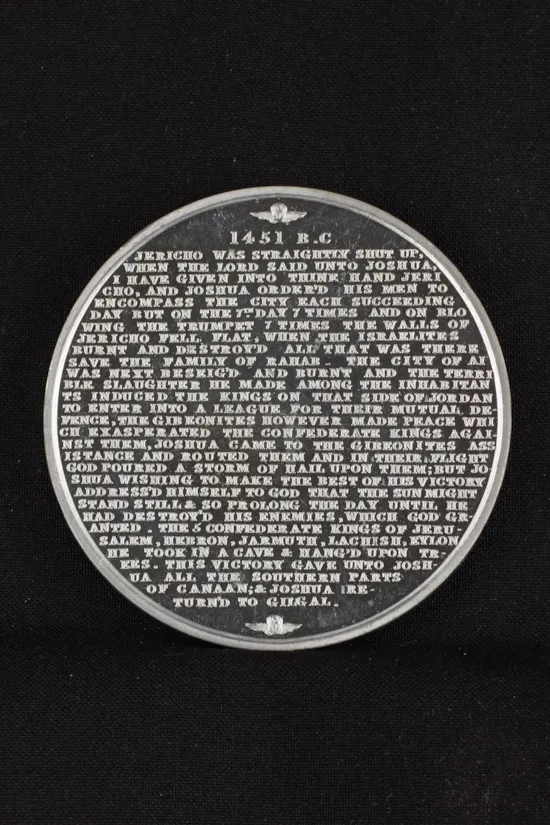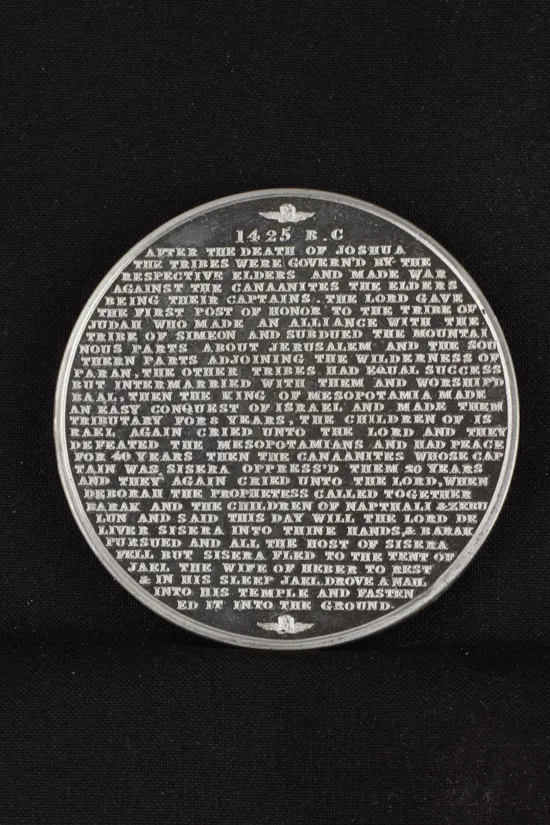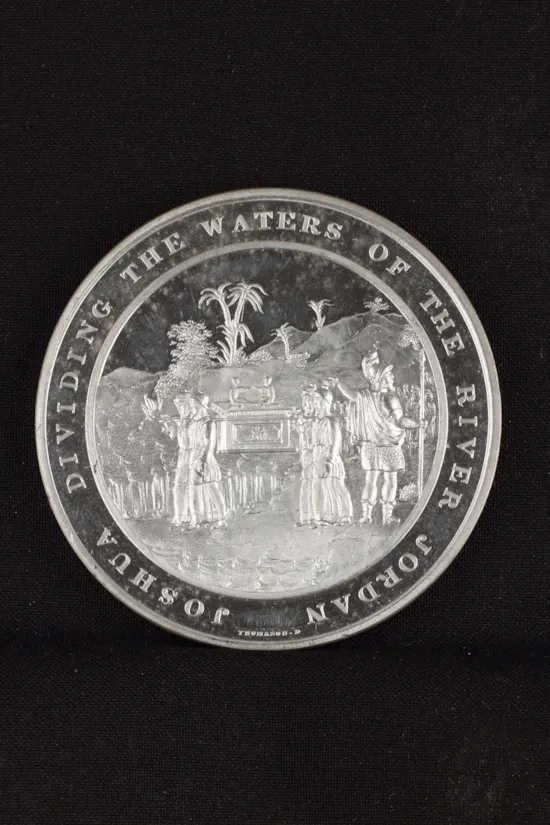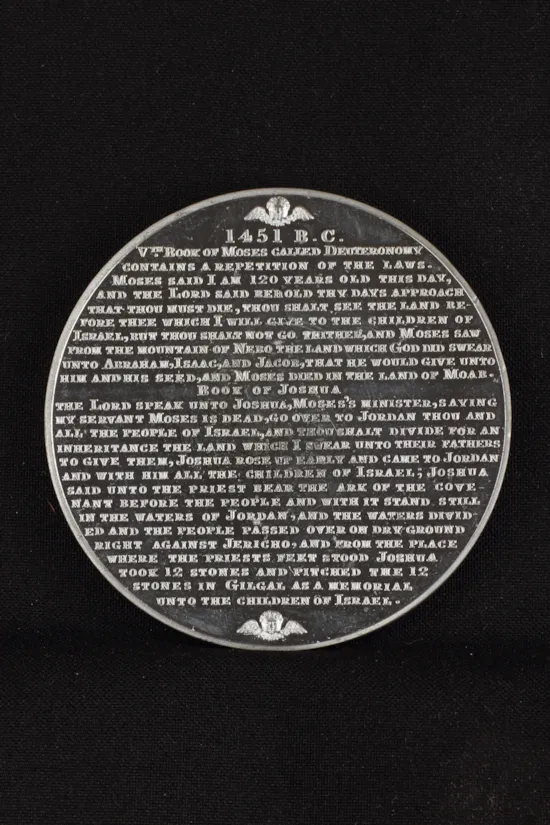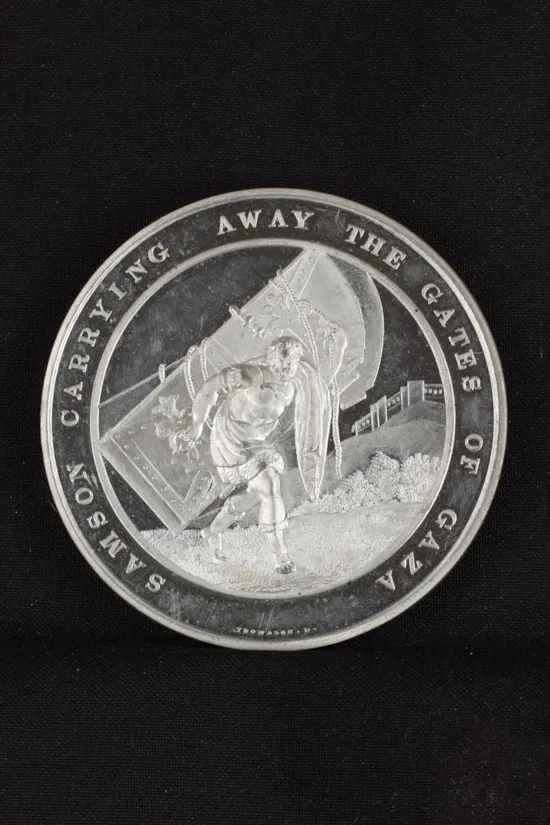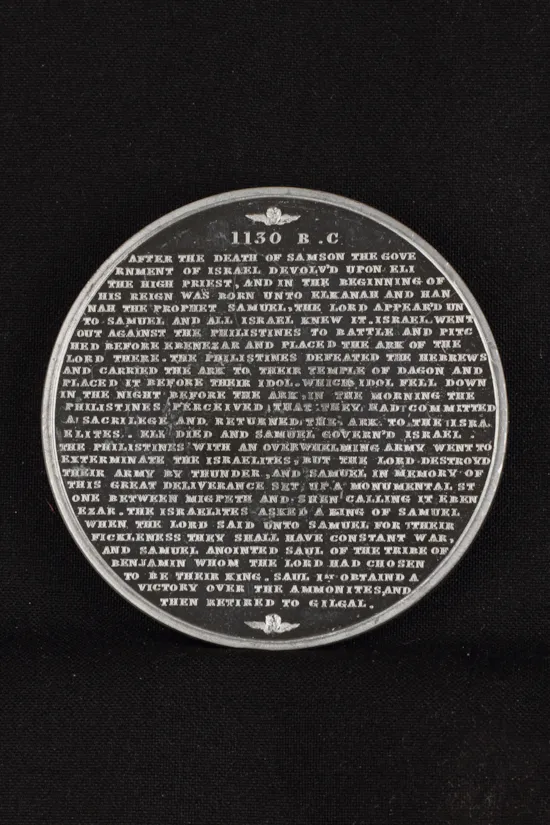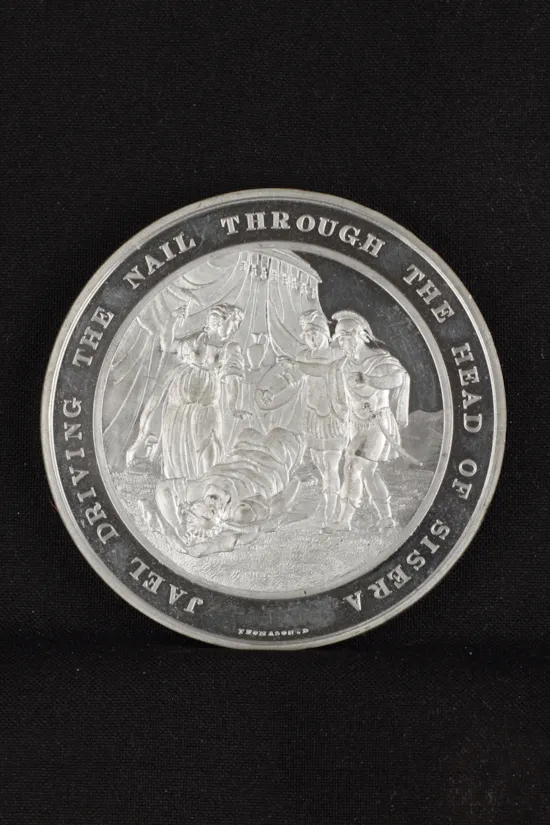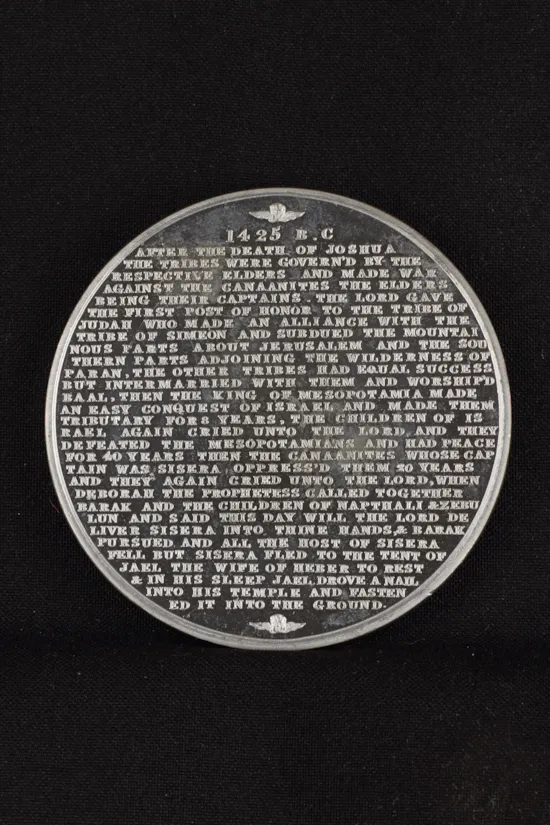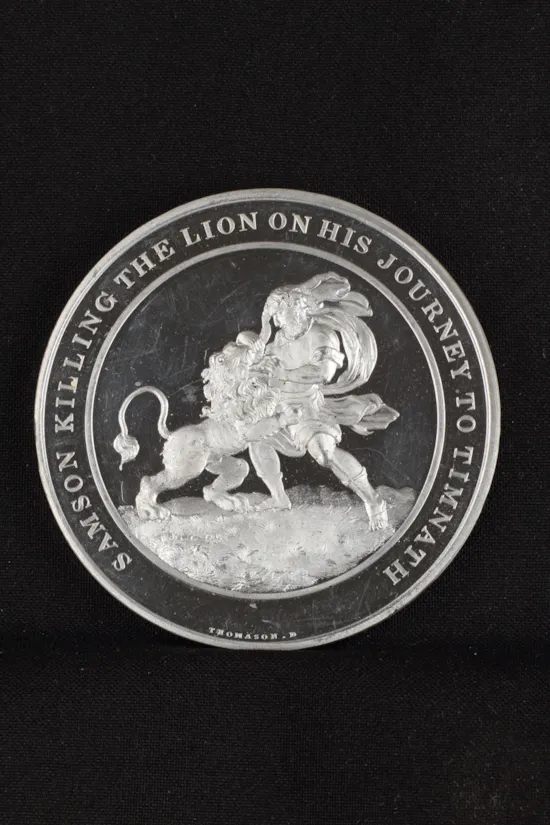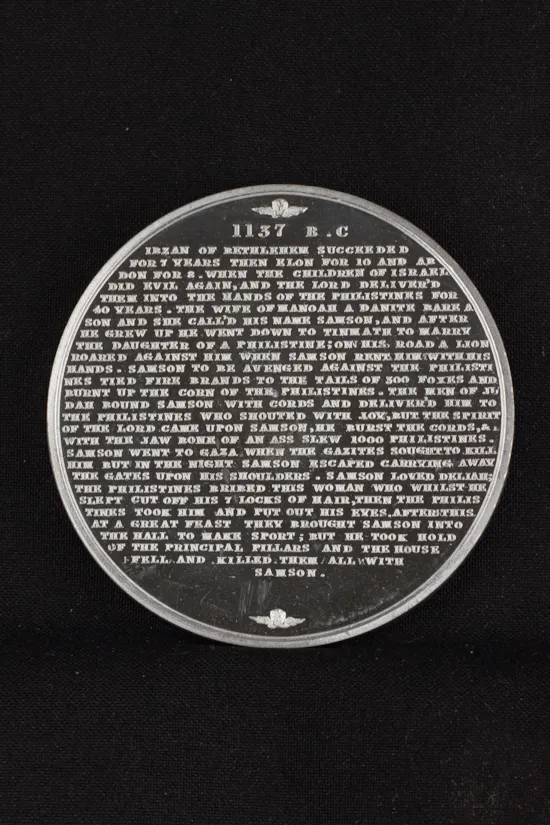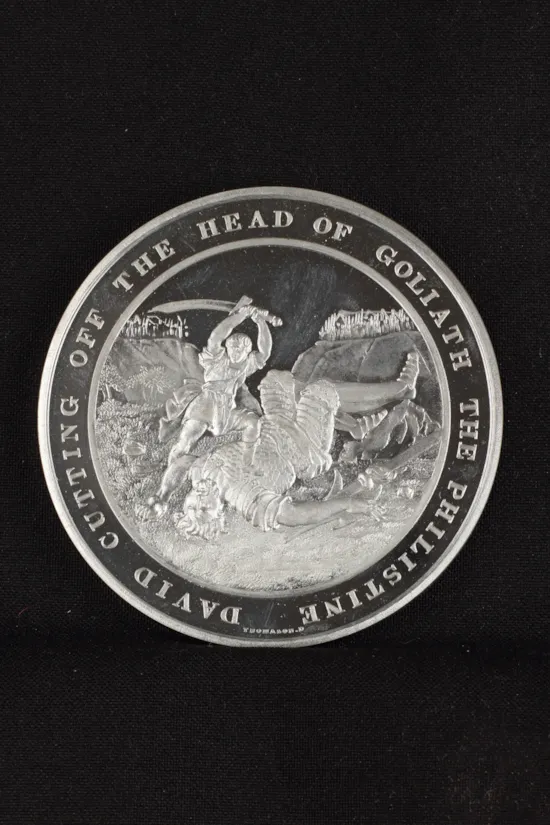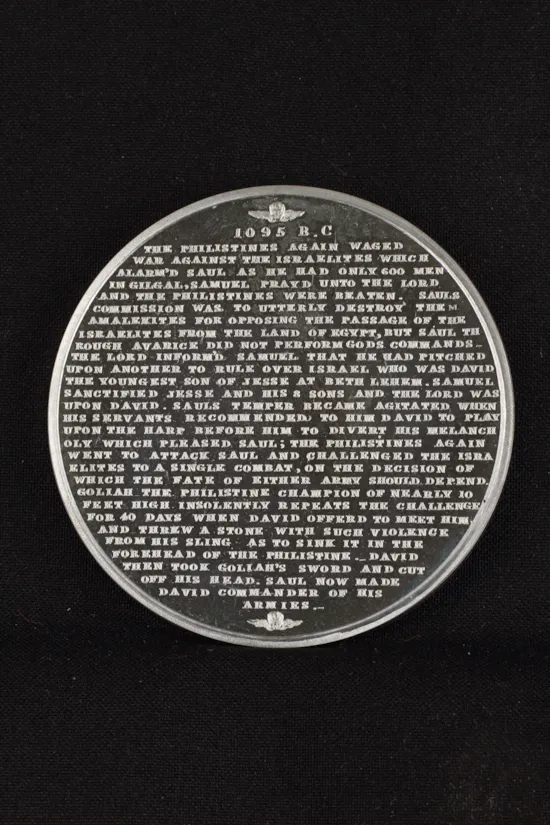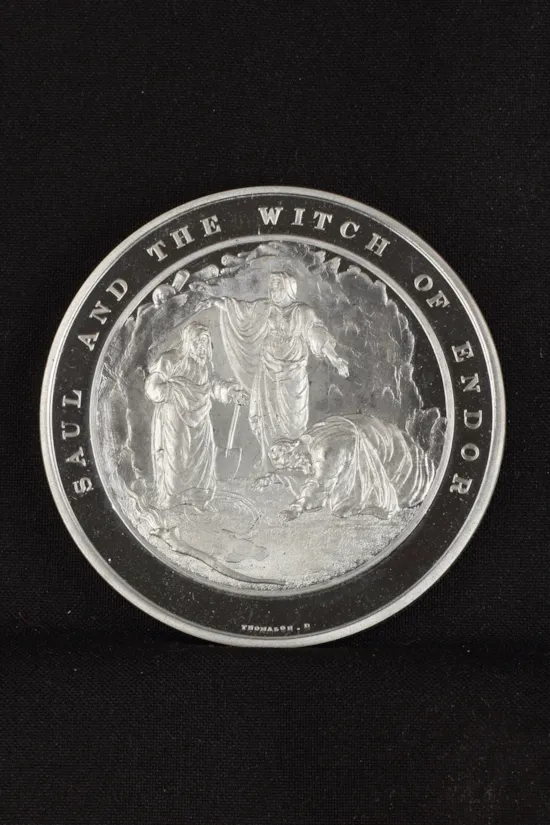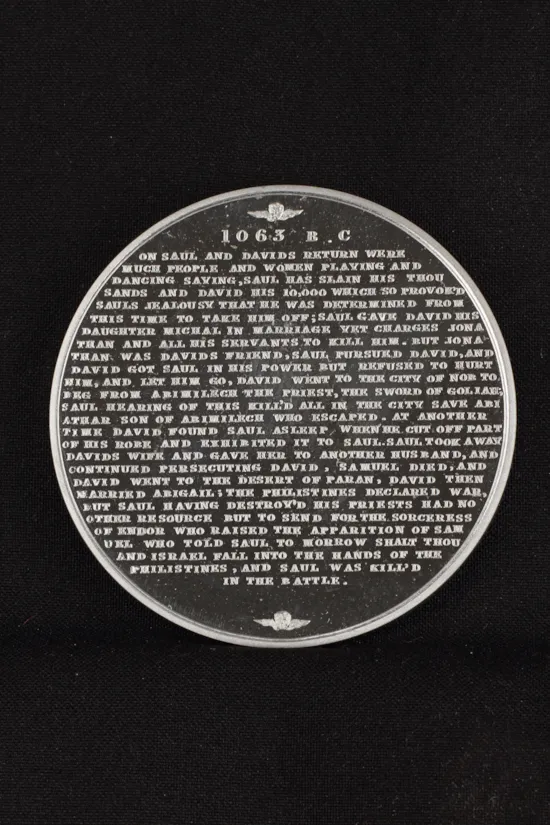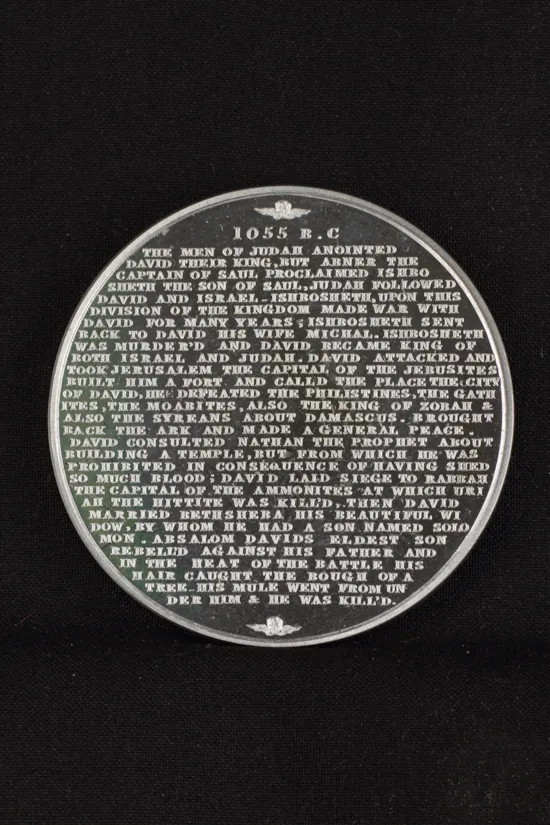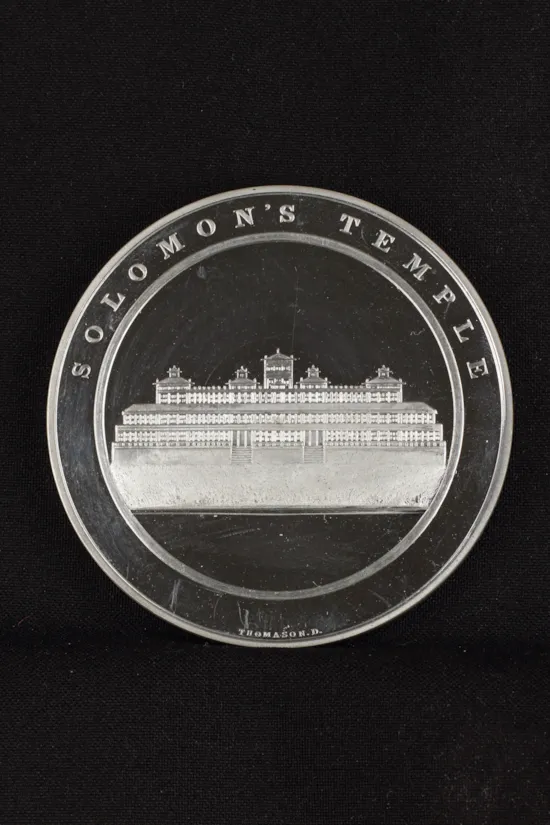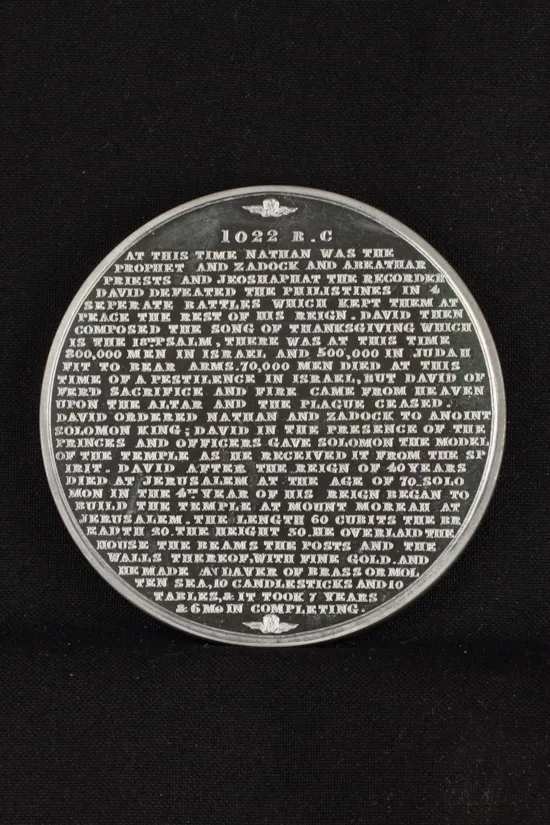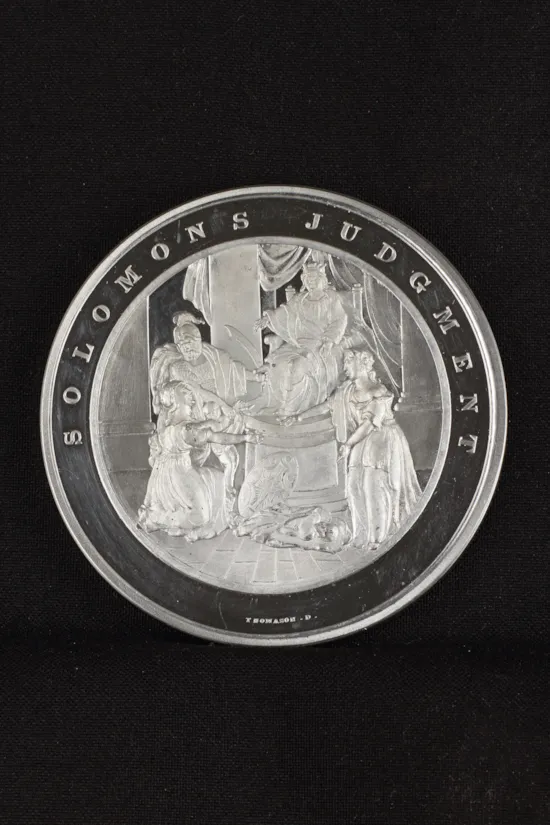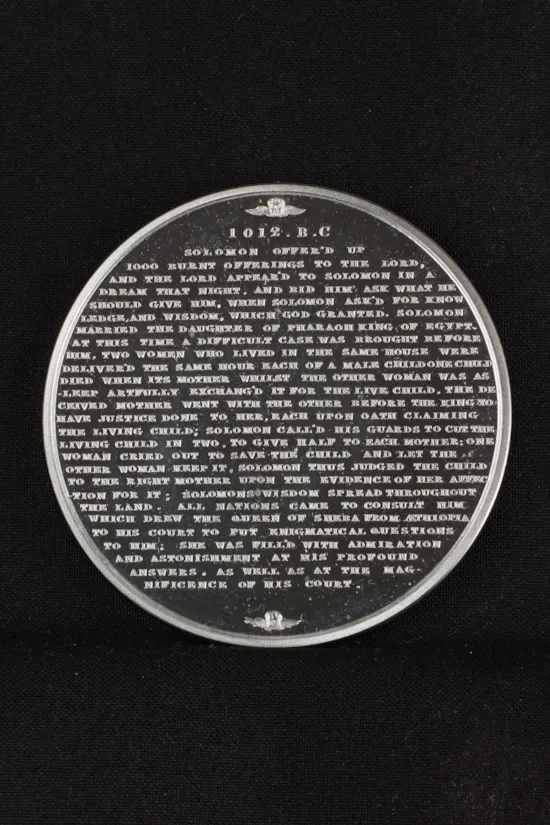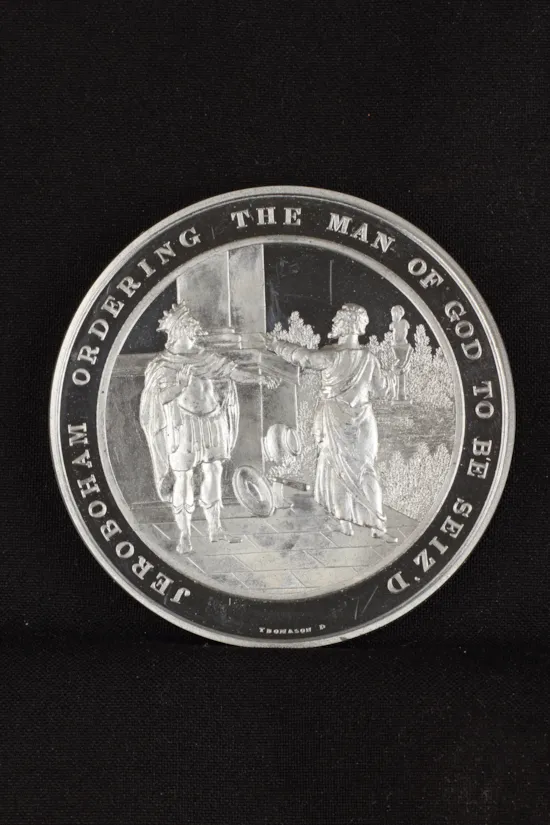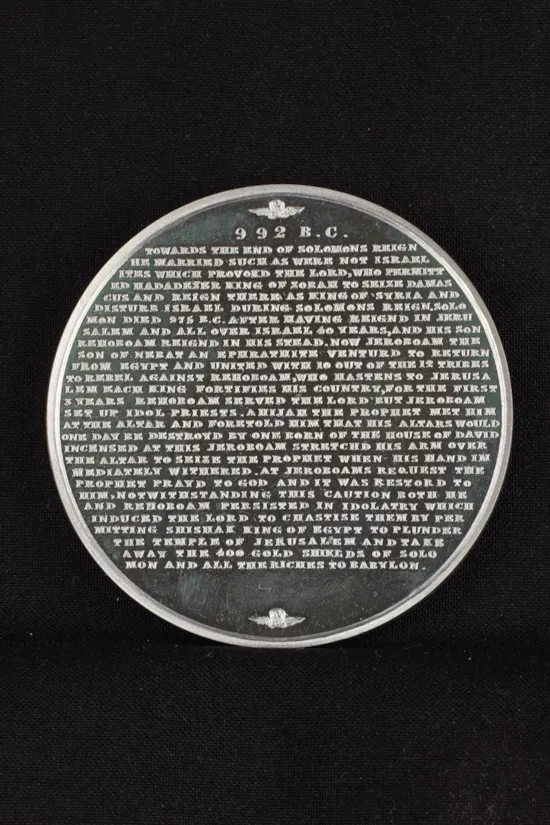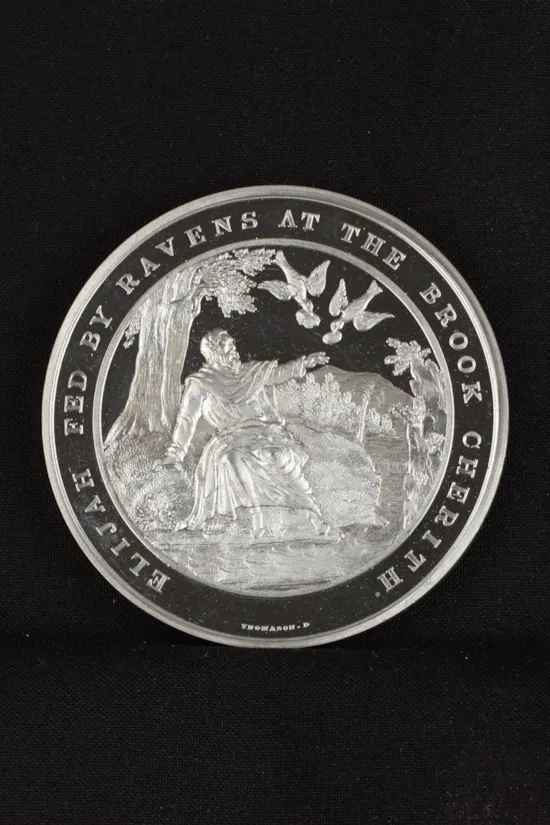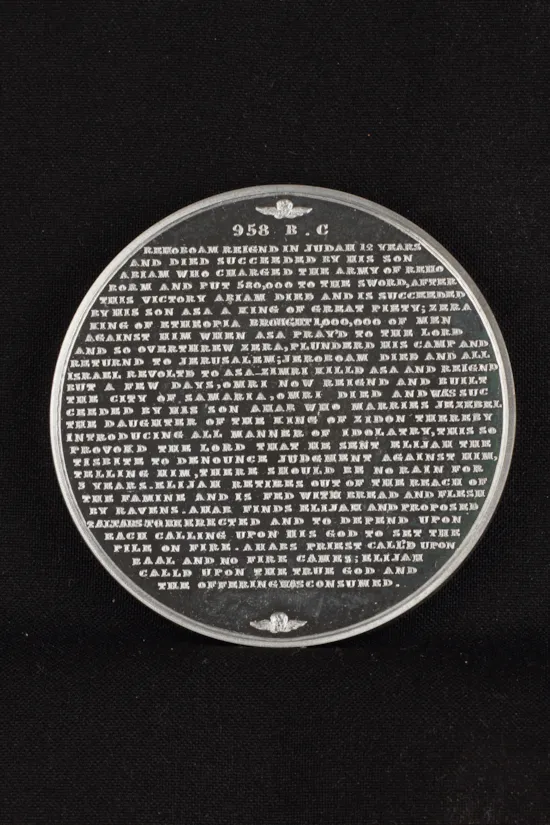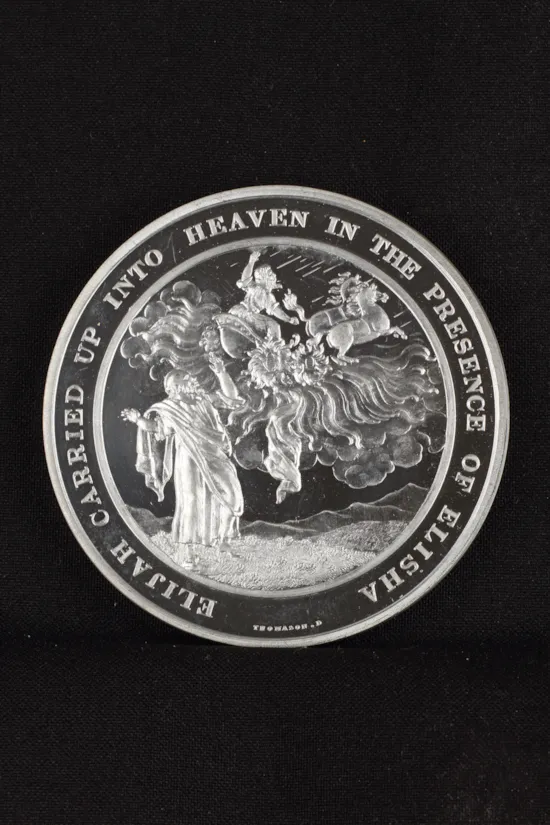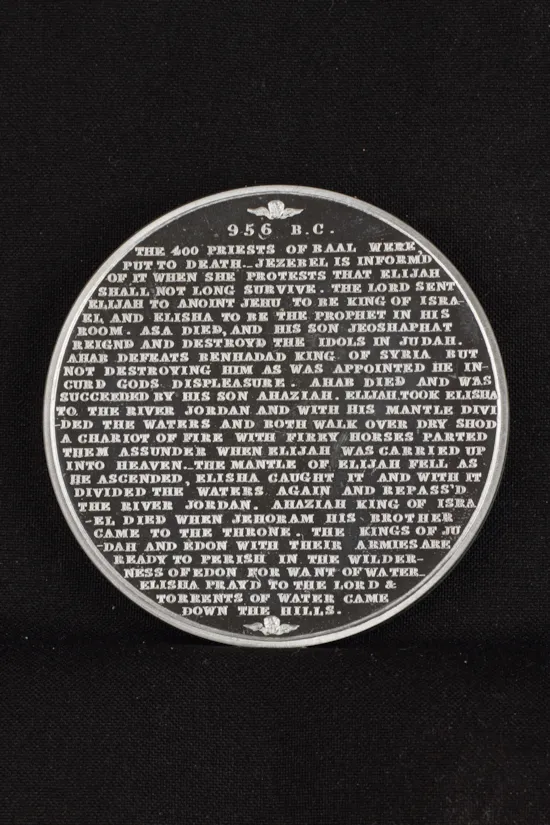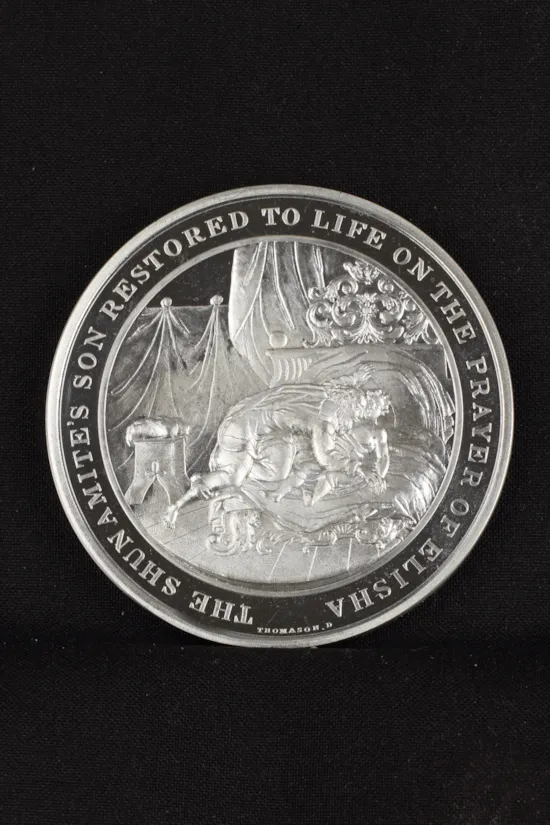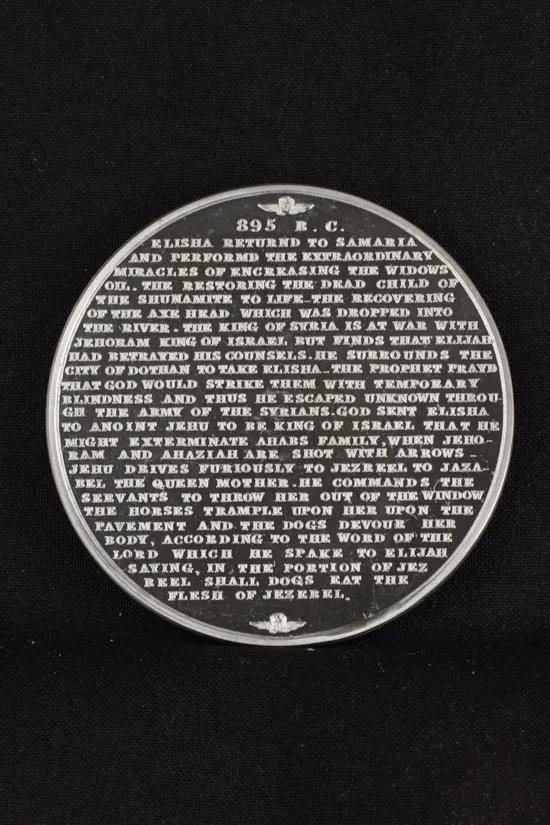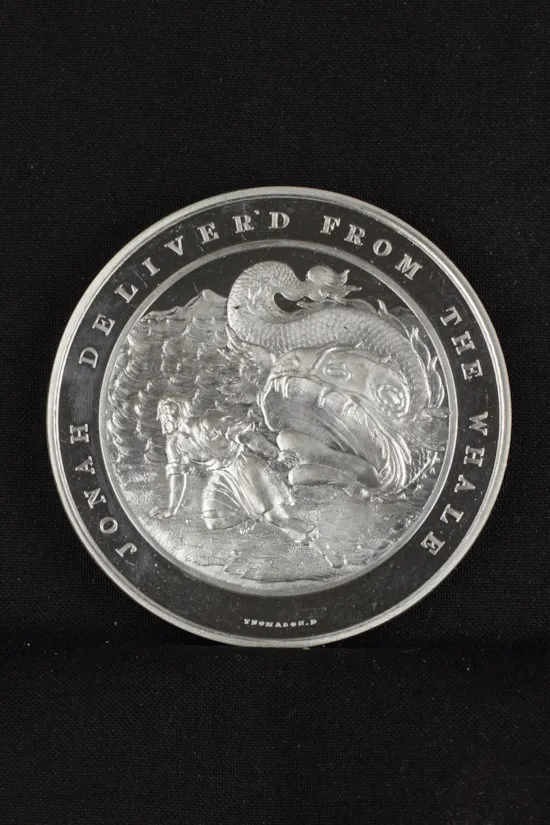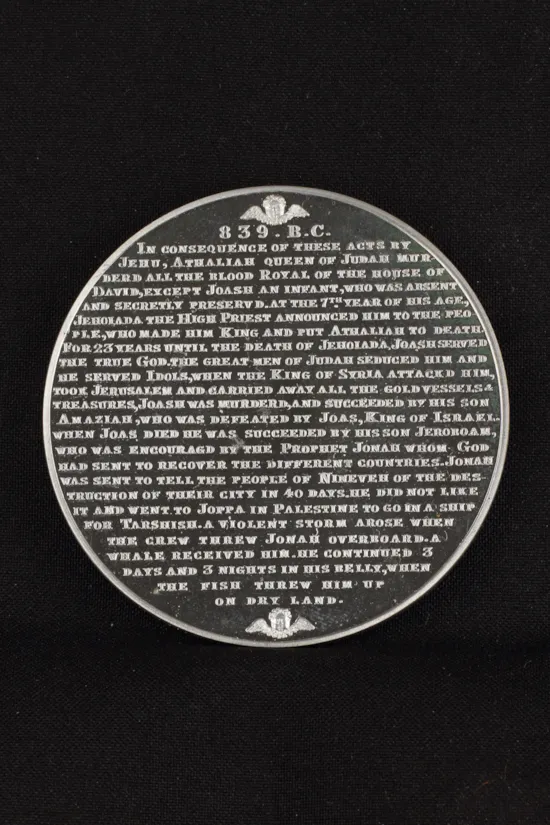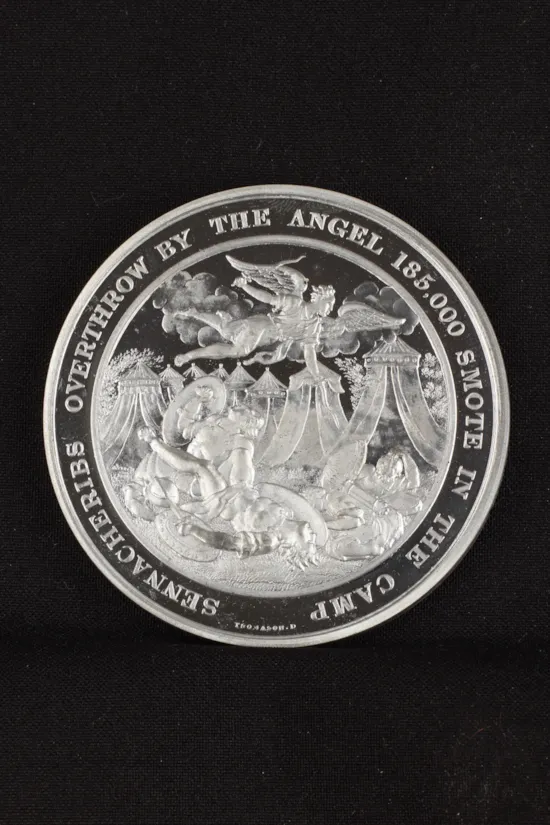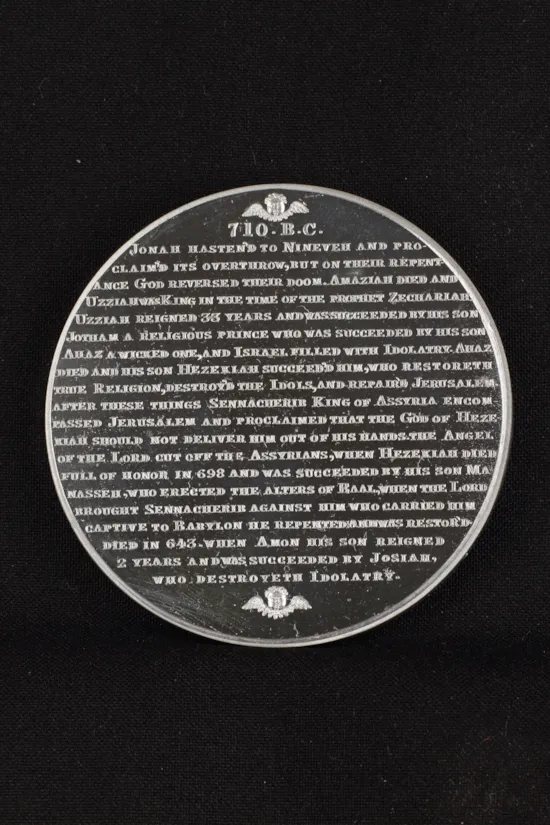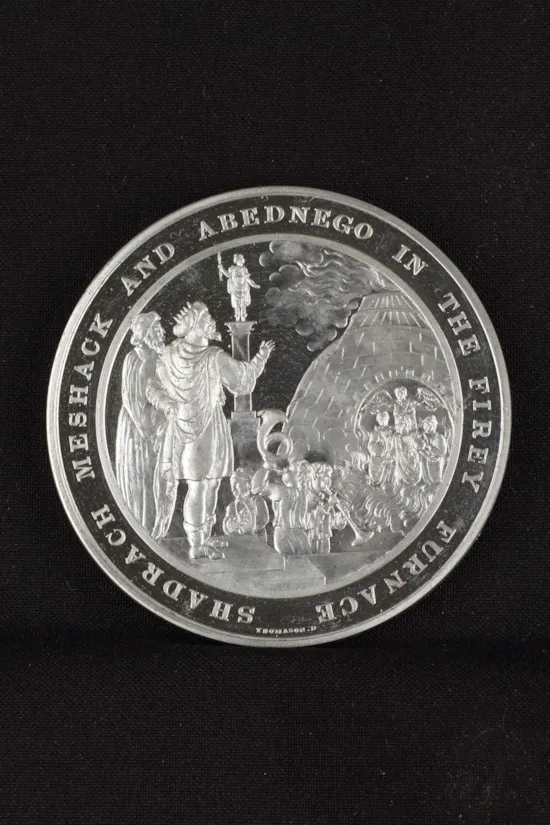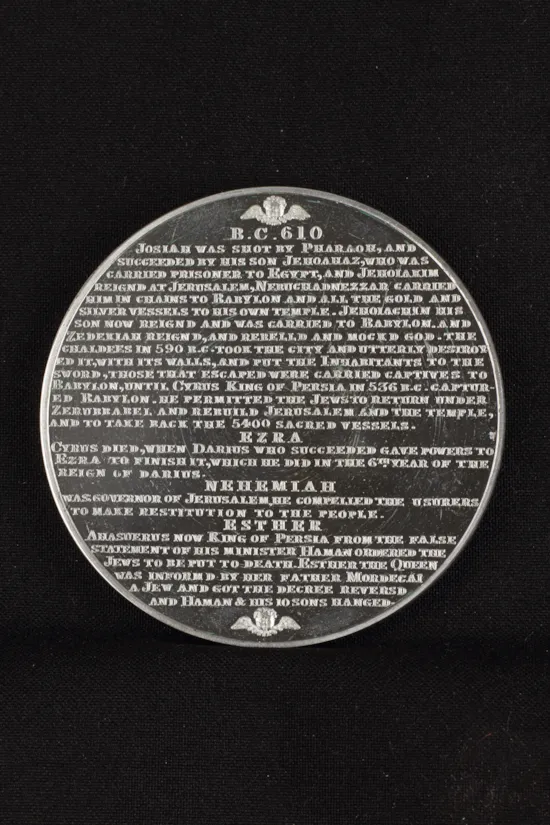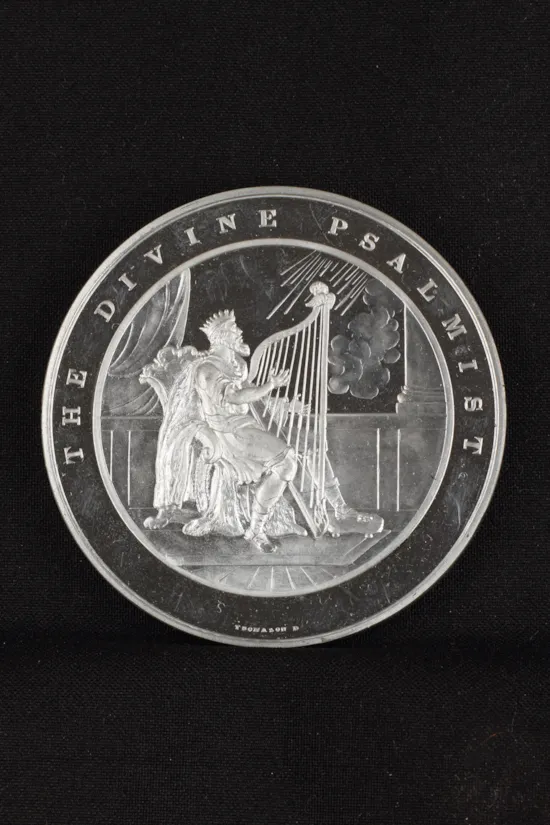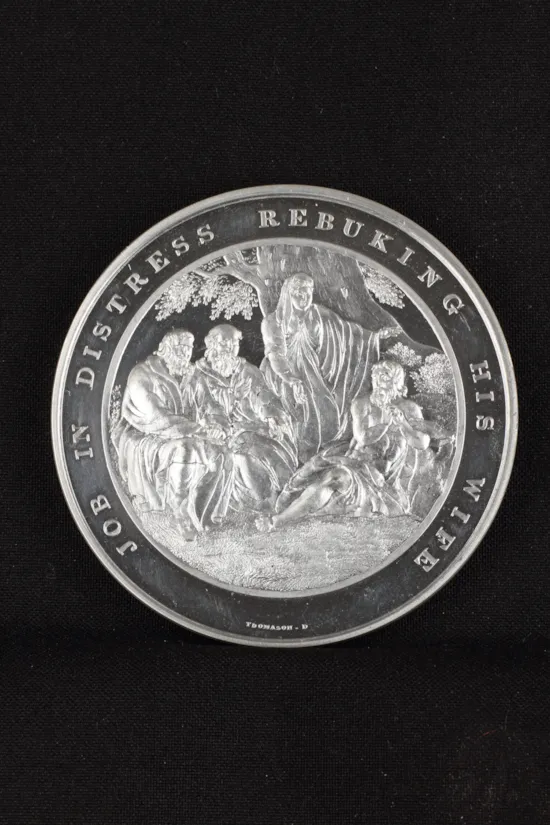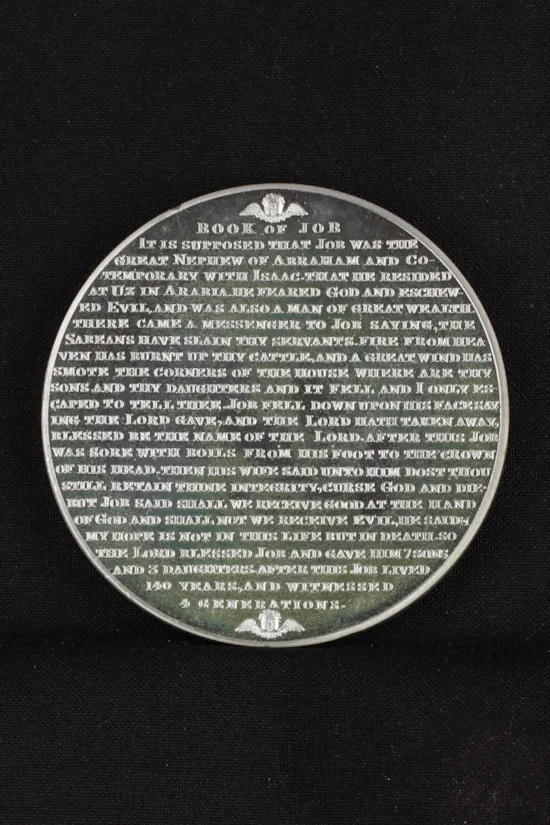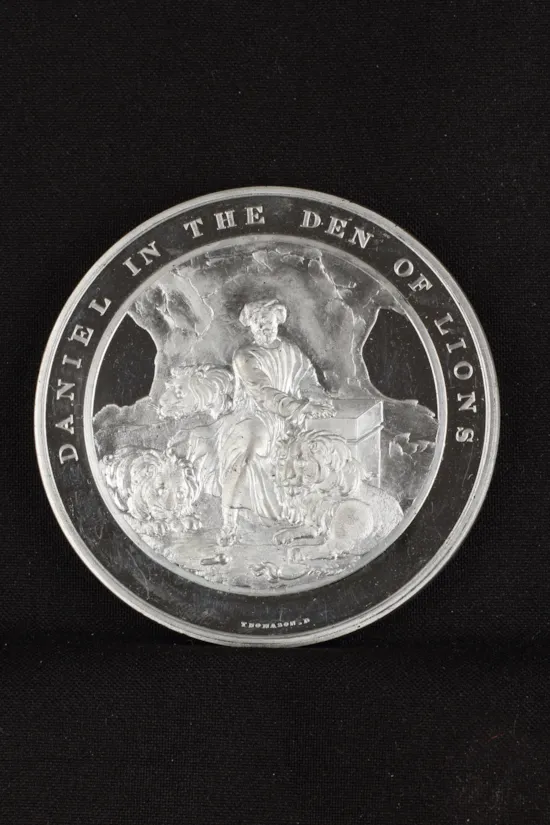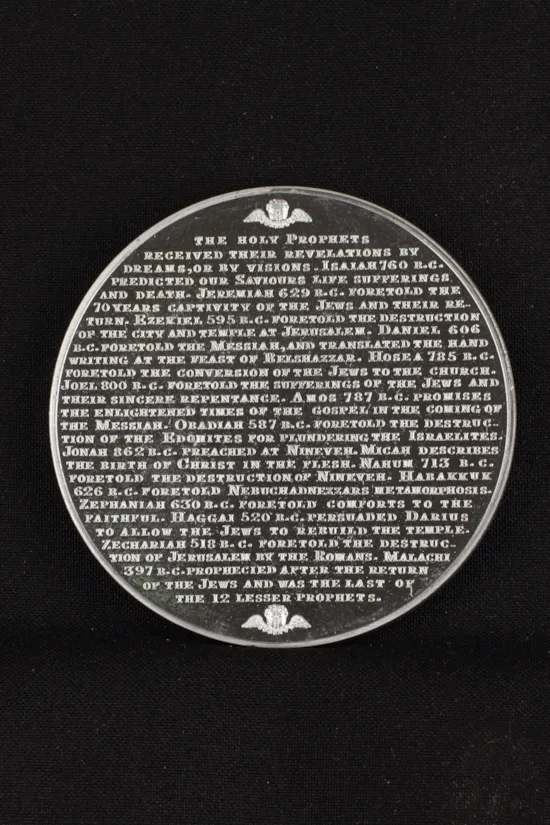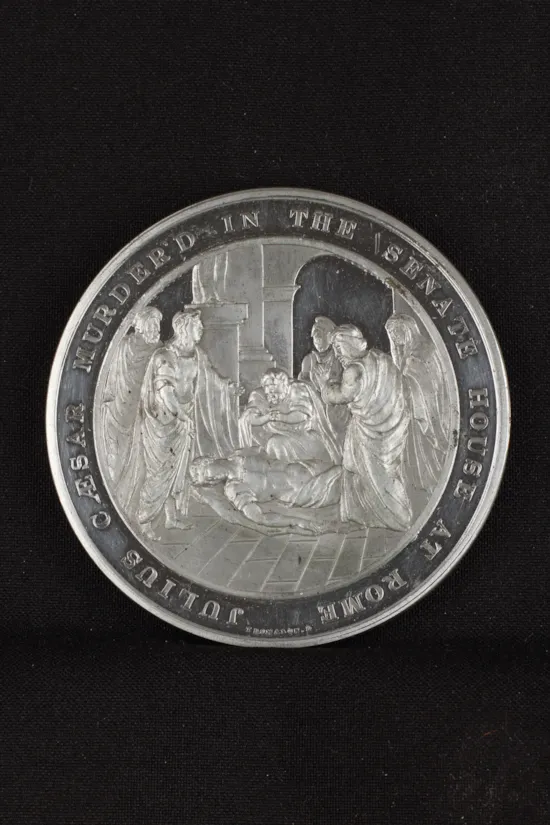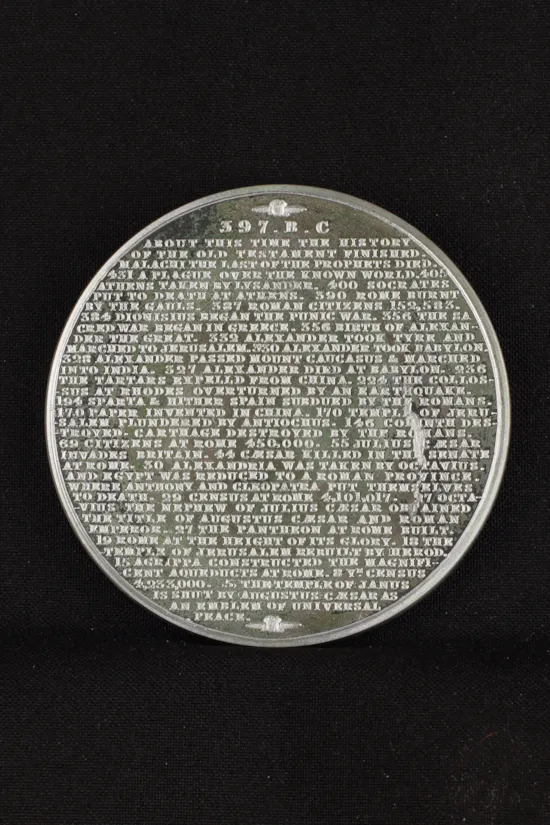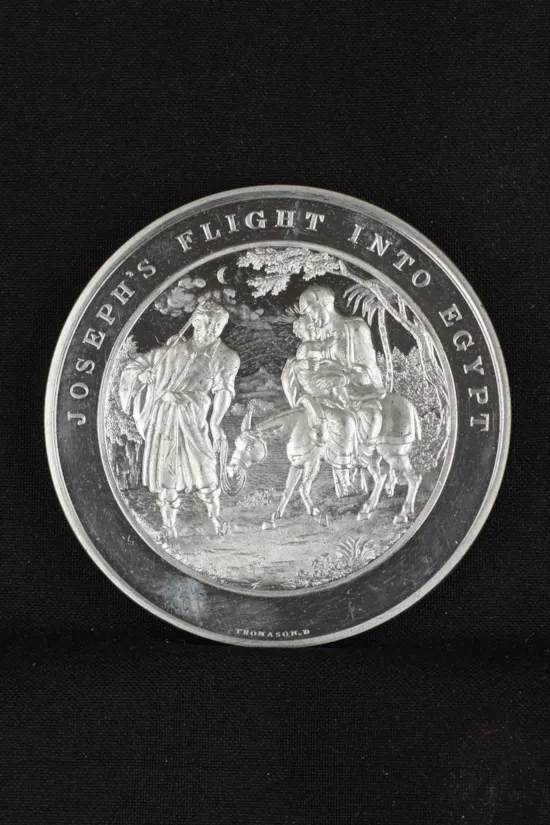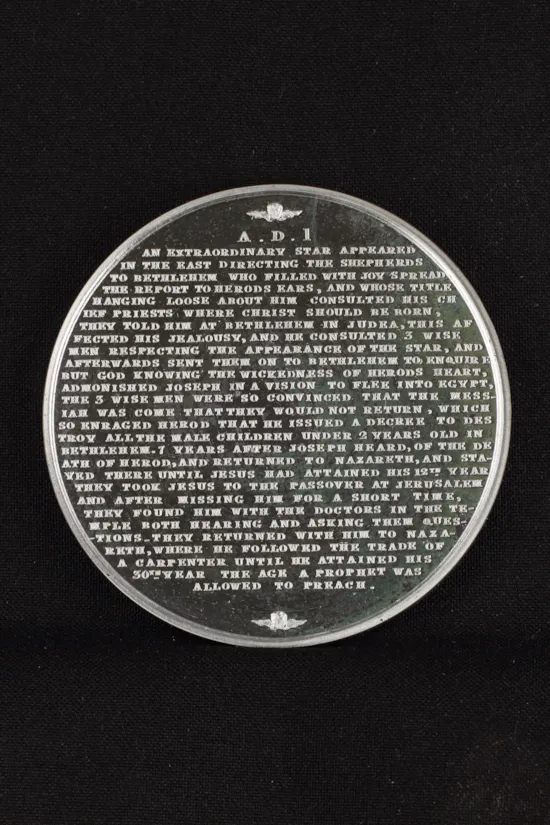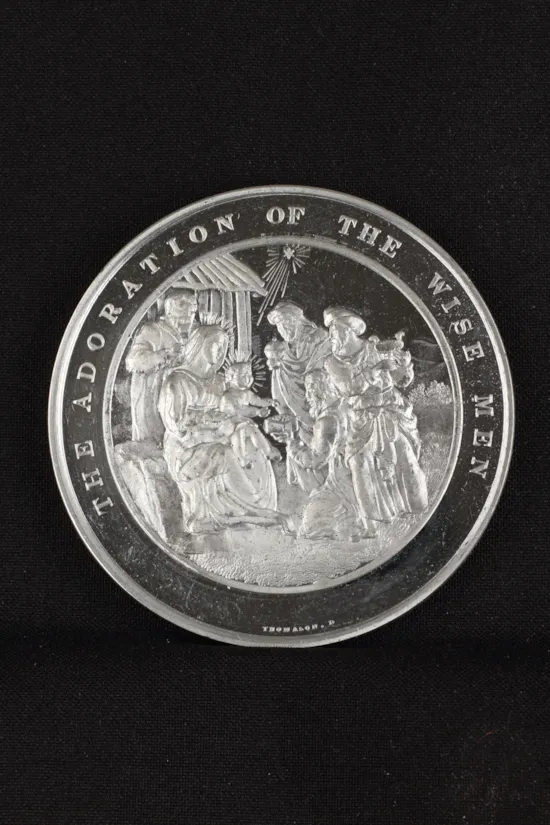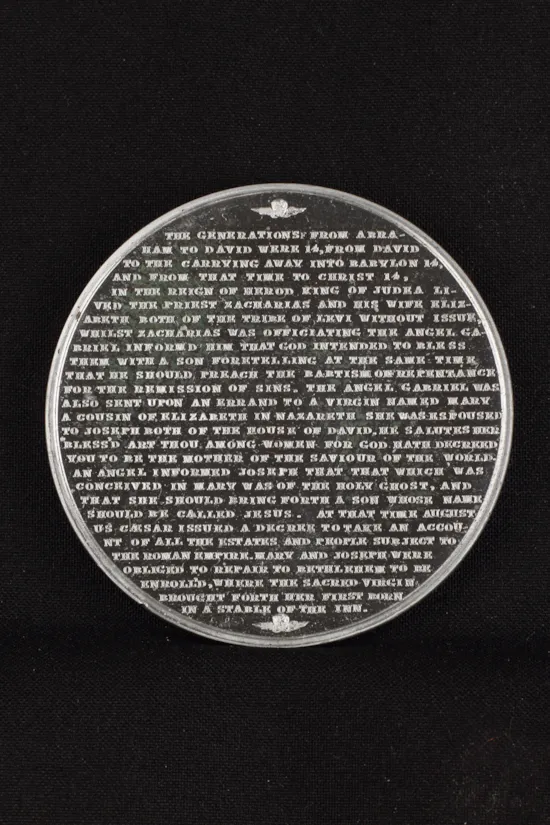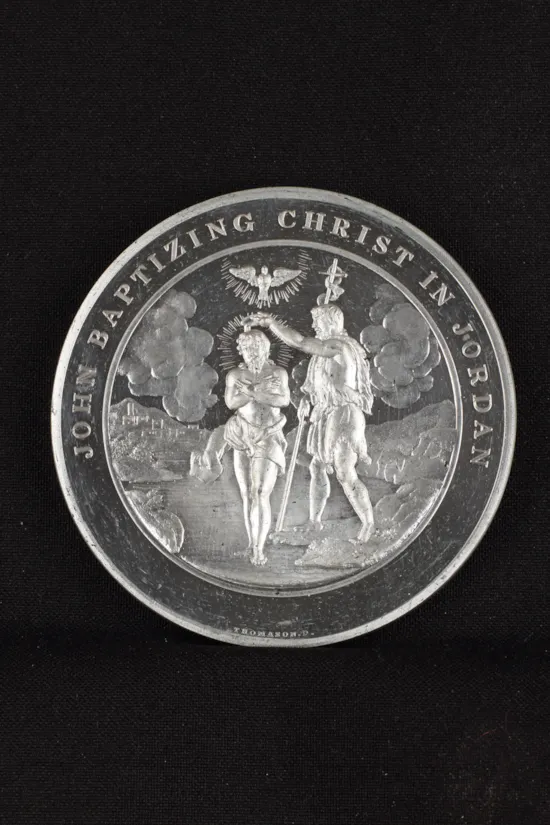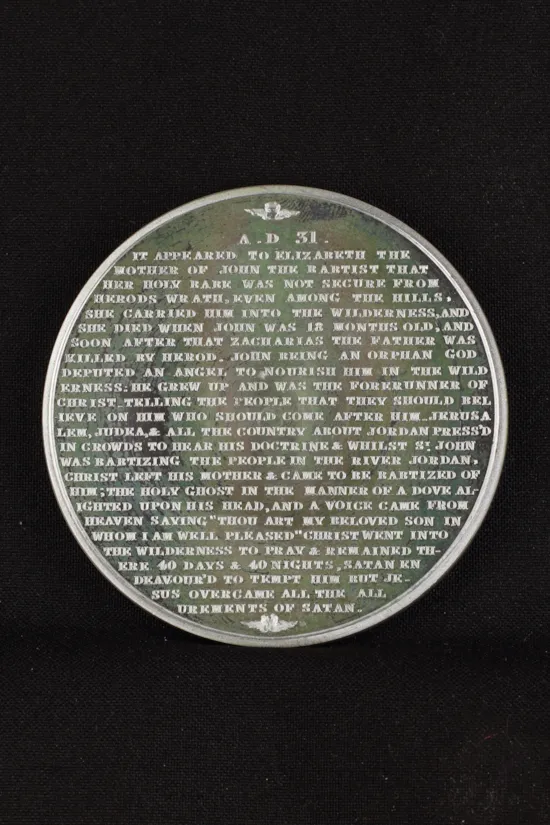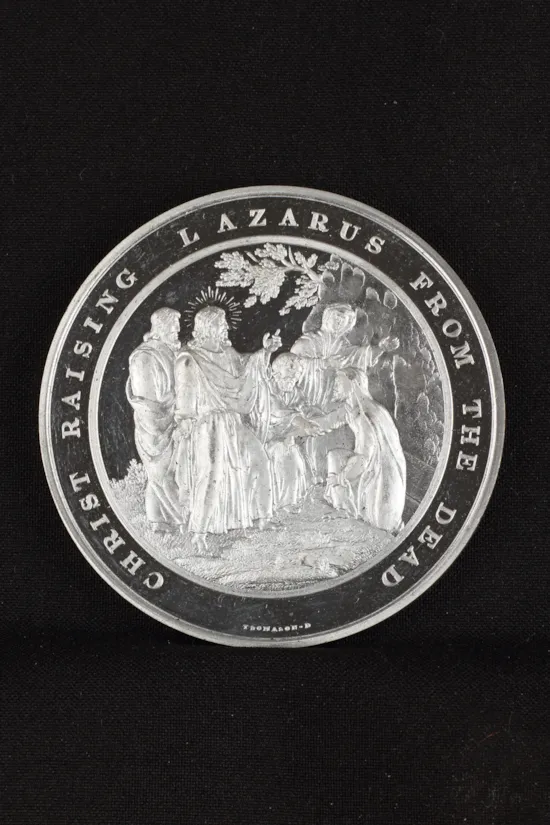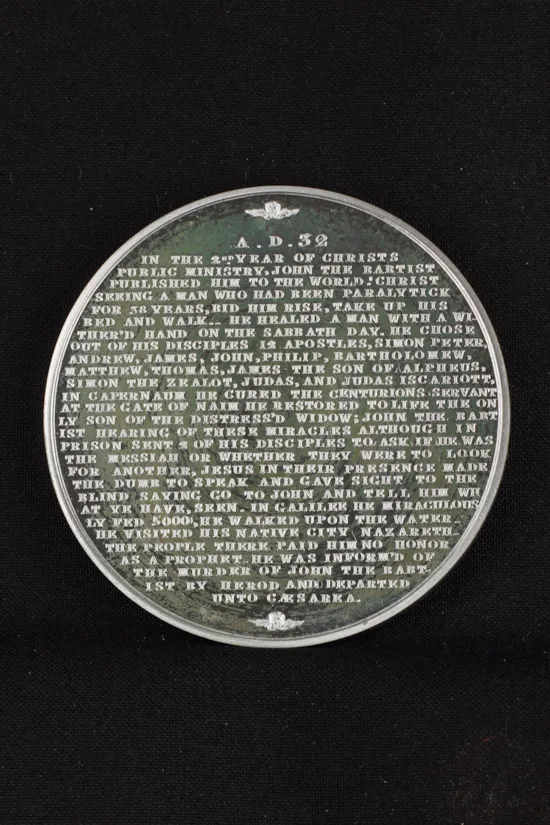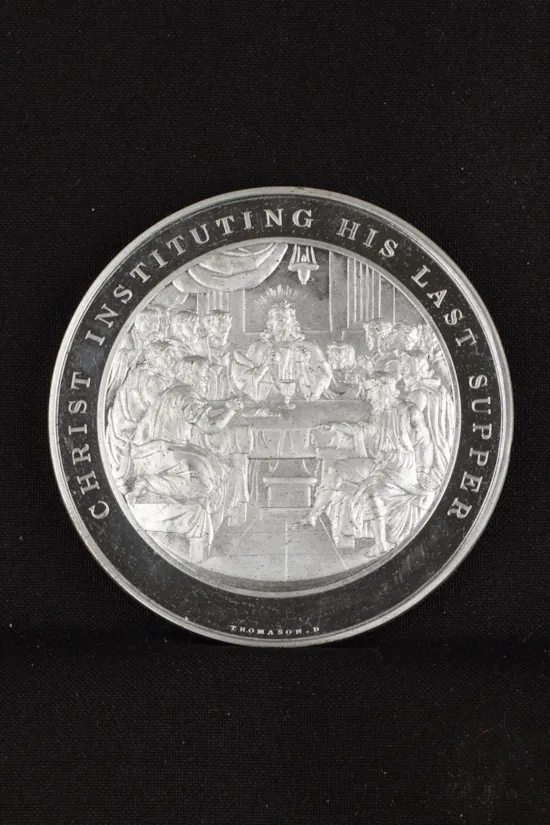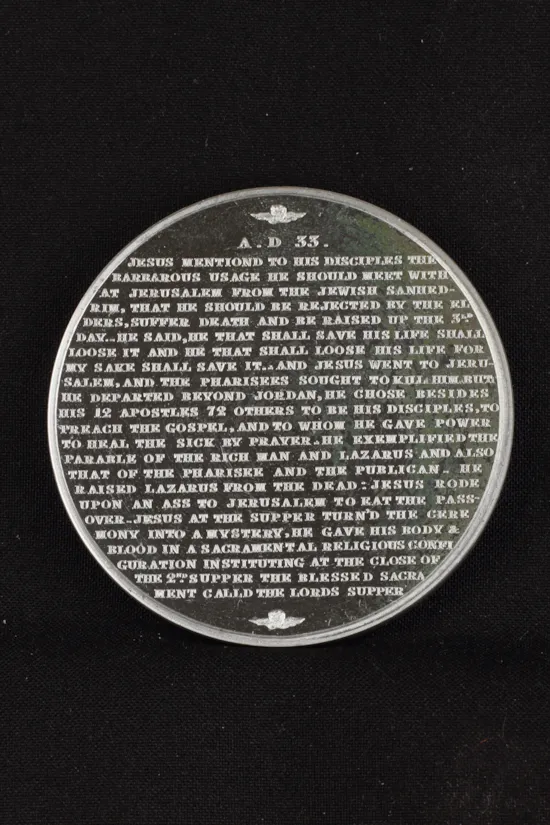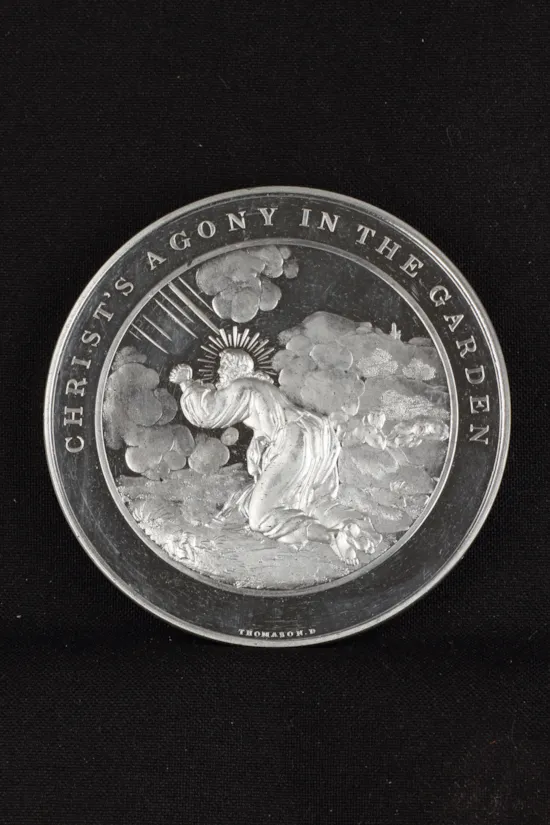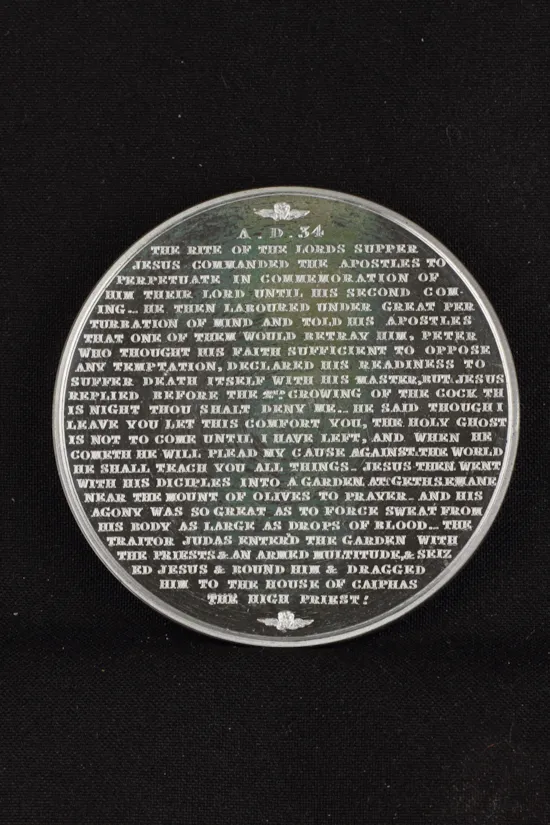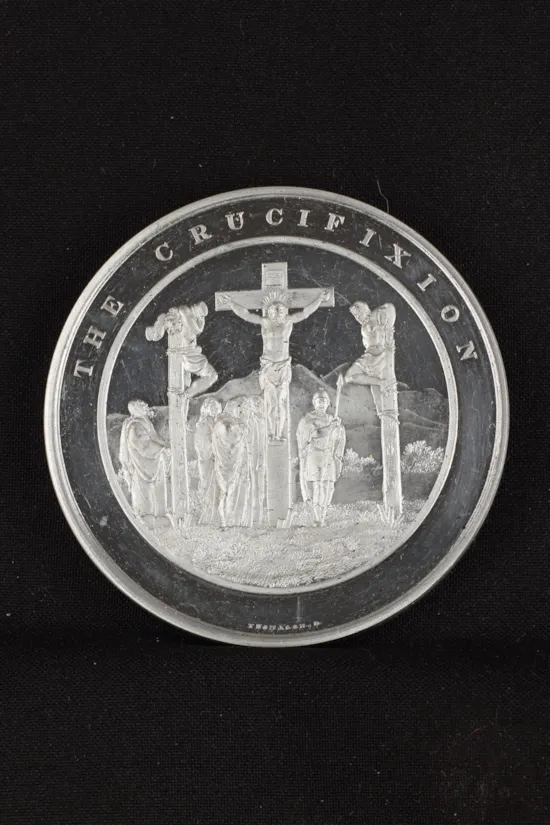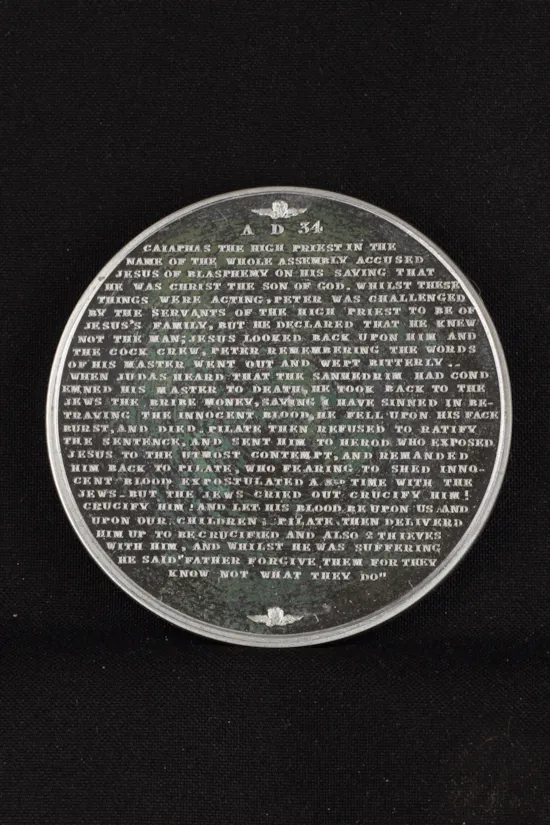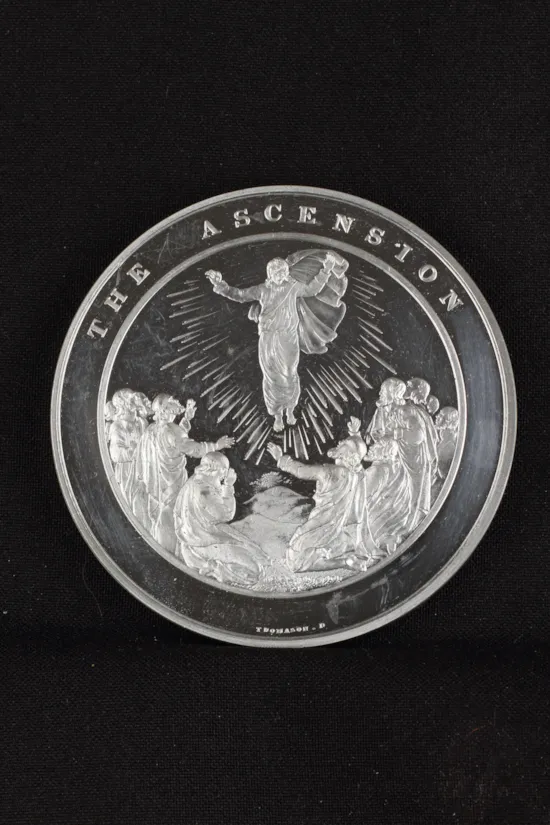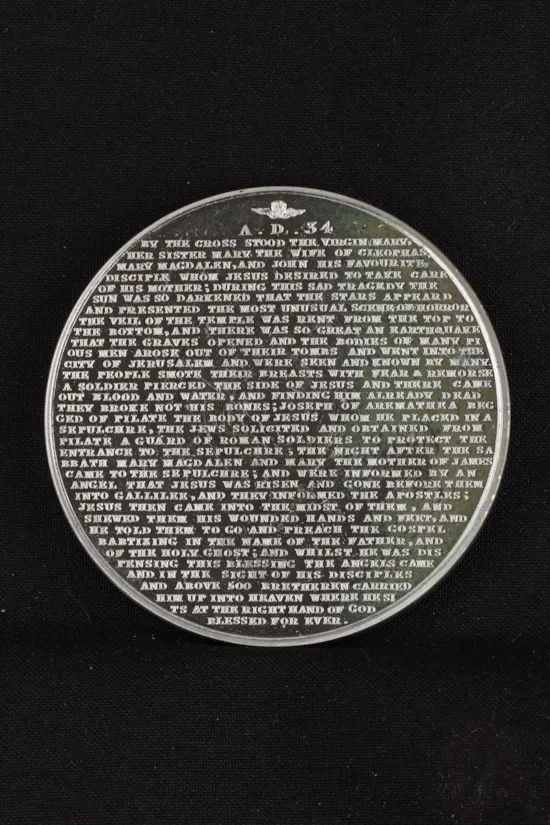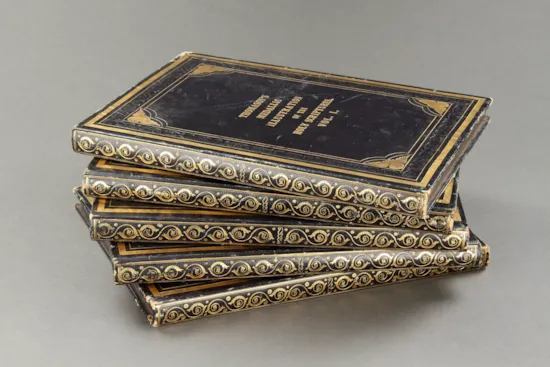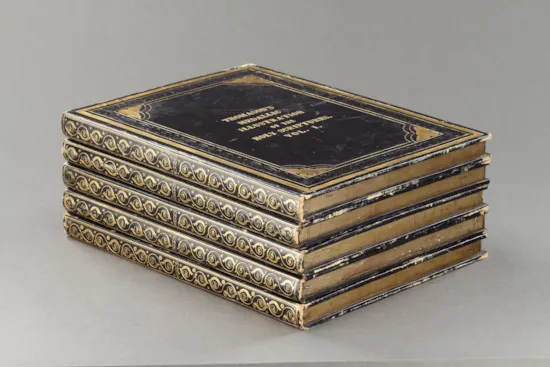The ‘Medallic Illustrations of The Holy Scriptures’ by Sir Edward Thomason inspired by Carlo Maratta (1625 - 1713)
The ‘Medallic Illustrations of The Holy Scriptures’ by Sir Edward Thomason inspired by Carlo Maratta (1625 - 1713)
An exceptional collection of ‘Sixty Medallions’ contained in their leather bound ‘Book’ volumes
Each medal detailing scenes taken from ‘Old Master’ paintings depicting scenes from the beginning of ‘Genesis’ to the ‘Ascension of Christ’.
Each medal virtually ‘as struck’ in exceptional ‘mint’ condition
White metal, leather, gilt, velvet, silk, paper
England
Circa 1830
SIZE: medals: 7.5cm dia - 3 ins dia. / case: 35.5cm high, 27cm wide, 3cm deep - 14 ins high, 10⅔ ins wide, 1¼ ins deep
An exceptional collection of ‘Sixty Medallions’ contained in their leather bound ‘Book’ volumes
Each medal detailing scenes taken from ‘Old Master’ paintings depicting scenes from the beginning of ‘Genesis’ to the ‘Ascension of Christ’.
Each medal virtually ‘as struck’ in exceptional ‘mint’ condition
White metal, leather, gilt, velvet, silk, paper
England
Circa 1830
SIZE: medals: 7.5cm dia - 3 ins dia. / case: 35.5cm high, 27cm wide, 3cm deep - 14 ins high, 10⅔ ins wide, 1¼ ins deep
The ‘Medallic Illustrations of The Holy Scriptures’ by Sir Edward Thomason inspired by Carlo Maratta (1625 - 1713)
An exceptional collection of ‘Sixty Medallions’ contained in their leather bound ‘Book’ volumes
Each medal detailing scenes taken from ‘Old Master’ paintings depicting scenes from the beginning of ‘Genesis’ to the ‘Ascension of Christ’.
Each medal virtually ‘as struck’ in exceptional ‘mint’ condition
White metal, leather, gilt, velvet, silk, paper
England
Circa 1830
SIZE: medals: 7.5cm dia - 3 ins dia. / case: 35.5cm high, 27cm wide, 3cm deep - 14 ins high, 10⅔ ins wide, 1¼ ins deep
An exceptional collection of ‘Sixty Medallions’ contained in their leather bound ‘Book’ volumes
Each medal detailing scenes taken from ‘Old Master’ paintings depicting scenes from the beginning of ‘Genesis’ to the ‘Ascension of Christ’.
Each medal virtually ‘as struck’ in exceptional ‘mint’ condition
White metal, leather, gilt, velvet, silk, paper
England
Circa 1830
SIZE: medals: 7.5cm dia - 3 ins dia. / case: 35.5cm high, 27cm wide, 3cm deep - 14 ins high, 10⅔ ins wide, 1¼ ins deep
note:
Inside, each cover bears a circular card reading: ‘Struck at the Works of G. R. Collins & Co. Successors to Sir E. Thomason, Church St. Birmᴹ’ (Birmingham, England) with instructions on how to handle the medals: ‘It is particularly requested that persons inspecting the Medals will not touch or rub the surface, a Ribbon being placed underneath to turn them over, the edges alone may be handled to take them from their Places’.
The fact that the medals have survived intact and are in outstanding original condition, would indicate the ‘rules’ of handling were followed to the ‘letter’. It is very rare to find a complete set, in their original volumes and intact.
Together with a list: ‘Embodied from Pictures of the Following Masters: Vol 1 to Vol 5 (listing each artist and their place of birth)
This extraordinary set of struck medals known as the ‘Thomason Medallic Bible’ of 1830 captures the ‘essence’ of the entire Holy Bible in ‘medallic art’. The obverse designs were inspired by the works of Renaissance artists and executed by several different engravers. The reverse contains a dense ‘text’ quotation or explanation describing the ‘topic’ of each medal.
Produced in Birmingham, England by Sir Edward Thomason, who felt divinely inspired to ‘promote the glory of God by impressing the Word of God upon gold, silver and other indestructible metals’. In Thomason’s Memoirs, ‘During Half a Century’, he wrote:
‘It appeared to me, in 1827, that I might, through God’s assistance, become a humble instrument to effect a unique and novel medallic work to further and promote the glory of God, by impressing the Word of God upon gold, silver and other indestructible metals, with emblematical and symbolical designs, and with a short condensed explanation on the reverses of the medals, and thereby be the first author of a ‘Medallic Bible’.
I first applied myself in reading over the sacred volume of the Bible, the authority of which is received by inspiration from God, and universally admitted. I found, after taking down copious notes that I should be unable by the most condensed arrangements to produce a tolerably continuous, or even contracted, development under a less number than sixty of the largest size medals….. the obverses of which to contain the historical devices, and the reverses filled with lettered explanation: and it was also essential for my purpose that the historical pieces should be obtained from the pictures of the Ancient Masters.
I did not despair in accomplishing this apparent difficulty in obtaining copies for my artists to work from, because I held at this period the appointment of eight consulships, from foreign governments, which gave me facility to procure copies of such pictures from the Continent which I might not conveniently find in England’.
I had been engaged for years upon the important series of Bible medals….. At this period (April 1830) my artists were upon the finish of the dies….. I took impressions in wax from about ten of them, with a determination of proceeding to Windsor to show his Majesty George IV what I had been for some years perfecting. His Majesty was delighted…. and said, ‘This is a work that shall not be hid under a bushel’.’
Inside, each cover bears a circular card reading: ‘Struck at the Works of G. R. Collins & Co. Successors to Sir E. Thomason, Church St. Birmᴹ’ (Birmingham, England) with instructions on how to handle the medals: ‘It is particularly requested that persons inspecting the Medals will not touch or rub the surface, a Ribbon being placed underneath to turn them over, the edges alone may be handled to take them from their Places’.
The fact that the medals have survived intact and are in outstanding original condition, would indicate the ‘rules’ of handling were followed to the ‘letter’. It is very rare to find a complete set, in their original volumes and intact.
Together with a list: ‘Embodied from Pictures of the Following Masters: Vol 1 to Vol 5 (listing each artist and their place of birth)
This extraordinary set of struck medals known as the ‘Thomason Medallic Bible’ of 1830 captures the ‘essence’ of the entire Holy Bible in ‘medallic art’. The obverse designs were inspired by the works of Renaissance artists and executed by several different engravers. The reverse contains a dense ‘text’ quotation or explanation describing the ‘topic’ of each medal.
Produced in Birmingham, England by Sir Edward Thomason, who felt divinely inspired to ‘promote the glory of God by impressing the Word of God upon gold, silver and other indestructible metals’. In Thomason’s Memoirs, ‘During Half a Century’, he wrote:
‘It appeared to me, in 1827, that I might, through God’s assistance, become a humble instrument to effect a unique and novel medallic work to further and promote the glory of God, by impressing the Word of God upon gold, silver and other indestructible metals, with emblematical and symbolical designs, and with a short condensed explanation on the reverses of the medals, and thereby be the first author of a ‘Medallic Bible’.
I first applied myself in reading over the sacred volume of the Bible, the authority of which is received by inspiration from God, and universally admitted. I found, after taking down copious notes that I should be unable by the most condensed arrangements to produce a tolerably continuous, or even contracted, development under a less number than sixty of the largest size medals….. the obverses of which to contain the historical devices, and the reverses filled with lettered explanation: and it was also essential for my purpose that the historical pieces should be obtained from the pictures of the Ancient Masters.
I did not despair in accomplishing this apparent difficulty in obtaining copies for my artists to work from, because I held at this period the appointment of eight consulships, from foreign governments, which gave me facility to procure copies of such pictures from the Continent which I might not conveniently find in England’.
I had been engaged for years upon the important series of Bible medals….. At this period (April 1830) my artists were upon the finish of the dies….. I took impressions in wax from about ten of them, with a determination of proceeding to Windsor to show his Majesty George IV what I had been for some years perfecting. His Majesty was delighted…. and said, ‘This is a work that shall not be hid under a bushel’.’
Lord de Saumarez, Scrubland Park, Suffolk
(inside each volume is a ‘crowned initial M’ for the original owner Sir William Fowle Middleton, 2nd Bt. of Cornfield and Shrubland)
Ex Private English collection
(inside each volume is a ‘crowned initial M’ for the original owner Sir William Fowle Middleton, 2nd Bt. of Cornfield and Shrubland)
Ex Private English collection
The ‘Medallic Illustrations of The Holy Scriptures’ by Sir Edward Thomason inspired by Carlo Maratta (1625 - 1713)
